National Mall
The National Mall is a landscaped park within the National Mall and Memorial Parks, an official unit of the United States National Park System. It is located near the downtown area of Washington, D.C., the capital city of the United States, and is administered by the National Park Service (NPS) of the United States Department of the Interior.[4]
National Mall | |
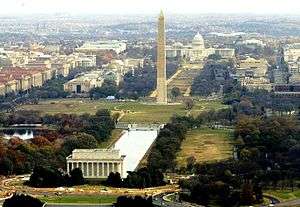 The National Mall in 2005, facing east from above the Potomac River | |
| Location | Between Independence and Constitution Avenues from the Capitol to the Lincoln Memorial |
|---|---|
| Coordinates | 38°53′24″N 77°1′25″W |
| Architect | Pierre (Peter) Charles L'Enfant; McMillan Commission |
| Website | National Mall and Memorial Parks |
| NRHP reference No. | 66000031[1] (original) 16000805[2][3] (increase) |
| Significant dates | |
| Added to NRHP | October 15, 1966 |
| Boundary increase | December 8, 2016 |
The term National Mall commonly includes areas that are also officially part of neighboring West Potomac Park and Constitution Gardens to the southwest. The term is often taken to refer to the entire area between the Lincoln Memorial on the west and east to the United States Capitol grounds, with the Washington Monument dividing the area slightly west of its midpoint.[5] A smaller designation sometimes referred to as the National Mall (proper) excludes both the Capitol grounds and the Washington Monument grounds, applying only to an area between them.[6]
The National Mall contains and borders a number of museums of the Smithsonian Institution, art galleries, cultural institutions, and various memorials, sculptures, and statues. The park receives approximately 24 million visitors each year.[7]
History
L'Enfant City Plan
In his 1791 plan for the future city of Washington, D.C., Pierre (Peter) Charles L'Enfant envisioned a garden-lined "grand avenue" approximately 1 mile (1.6 km) in length and 400 feet (120 m) wide, in an area that would lie between the Congress House (now the United States Capitol) and an equestrian statue of George Washington. The statue would be placed directly south of the President's House (now the White House) (see L'Enfant Plan).[8][9][10] The National Mall (proper) occupies the site of this planned "grand avenue", which was never constructed.
Mathew Carey's 1802 map is reported to be the first to name the area west of the United States Capitol as the "Mall".[11] The name is derived from that of The Mall in London, which during the 1700s was a fashionable promenade near Buckingham Palace upon which the city's elite strolled.[12]
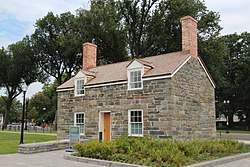
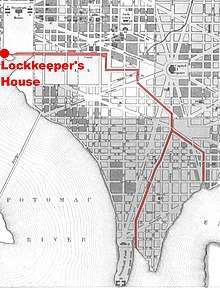
The Washington City Canal, completed in 1815 in accordance with the L'Enfant Plan, travelled along the former course of Tiber Creek to the Potomac River along B Street, NW (now Constitution Avenue, NW) and south along the base of a hill containing the Congress House, thus defining the northern and eastern boundaries of the Mall.[13][14][15] Being shallow and often obstructed by silt, the canal served only a limited role and became an open sewer that poured sediment and waste into the Potomac River's flats and shipping channel.[13][16] The portion of the canal that traveled near the Mall was covered over in 1871 for sanitary reasons.[13]
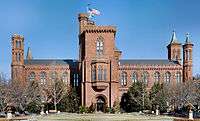
Some consider a lockkeeper's house constructed in 1837 near the western end of the Washington City Canal for an eastward extension of the Chesapeake & Ohio Canal to be the oldest building still standing on the National Mall.[17] The structure, which is located near the southwestern corner of 17th Street, NW and Constitution Avenue, NW, is west of the National Mall (proper).[15][18]
The Smithsonian Institution Building ("The Castle"), constructed from 1847 to 1855, is the oldest building now present on the National Mall (proper).[19] The Washington Monument, whose construction began in 1848 and reached completion in 1888, stands near the planned site of its namesake's equestrian statue.[20]
Downing Plan
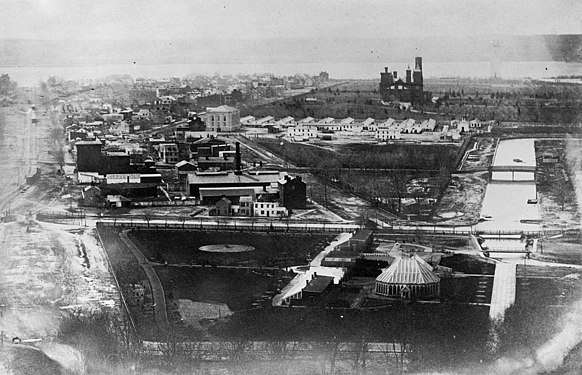 1863 photograph of the National Mall and vicinity during the Civil War, looking west towards the U.S. Botanical Garden, Washington City Canal, Gas Works, railroad tracks, Washington Armory and Armory Square Hospital buildings. The Smithsonian Institution Building, the uncompleted Washington Monument (behind the Smithsonian's building) and the Potomac River are in the background.
1863 photograph of the National Mall and vicinity during the Civil War, looking west towards the U.S. Botanical Garden, Washington City Canal, Gas Works, railroad tracks, Washington Armory and Armory Square Hospital buildings. The Smithsonian Institution Building, the uncompleted Washington Monument (behind the Smithsonian's building) and the Potomac River are in the background.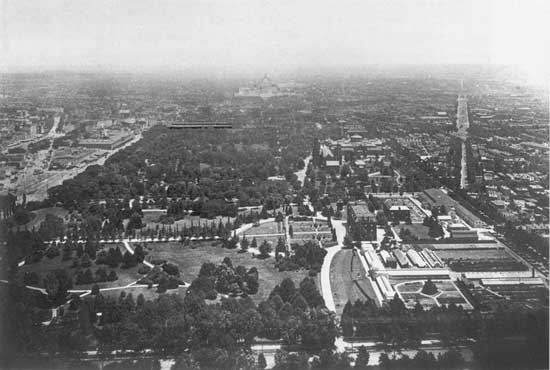 Looking east from the top of the Washington Monument towards the United States Capitol in the summer of 1901. The Mall exhibited the Victorian-era landscape of winding paths and random plantings that Andrew Jackson Downing designed in the 1850s
Looking east from the top of the Washington Monument towards the United States Capitol in the summer of 1901. The Mall exhibited the Victorian-era landscape of winding paths and random plantings that Andrew Jackson Downing designed in the 1850s
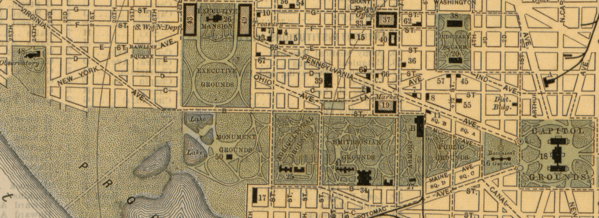
During the early 1850s, architect and horticulturist Andrew Jackson Downing designed a landscape plan for the Mall.[9][22][23] Over the next half century, federal agencies developed several naturalistic parks within the Mall in accordance with Downing's plan.[9][22] Two such areas were Henry Park and Seaton Park.[24]
During that period, the Mall was subdivided into several areas along B Street NW:
- The Monument Grounds between 17th and 14th Street NW
- The Agricultural Grounds between 14th and 12th Street NW
- The Smithsonian Grounds between 12th and 7th Street NW
- The Armory Square between 7th and 6th Street NW
- The Public Grounds between 6th and 2nd Street NW[25]
In 1856, the Armory (No. 27 on the 1893 map of the Mall) was built at the intersection of B Street SW and 6th Street SW on the Armory Grounds. In 1862, during the American Civil War, the building was converted to a military hospital known as Armory Square Hospital to house Union Army casualties. After the war ended, the Armory building became the home of the United States Fish Commission.[26]
The United States Congress established the United States Department of Agriculture in 1862 during the Civil War.[27] Designed by Adolf Cluss and Joseph von Kammerhueber, the United States Department of Agriculture Building (No. 25 on the map), was constructed in 1867–1868 on a 35-acre site on the Mall.[28]
After the Civil War ended, the Department of Agriculture started growing experimental crops and demonstration gardens on the Mall. These gardens extended from the Department's building on the south side of the Mall to B Street NW (the northern boundary of the Mall). The building was razed in 1930.[27] In addition, greenhouses belonging to the U.S. Botanical Garden (No. 16 on the map) appeared near the east end of the Mall between the Washington City Canal and the Capitol (later between 1st and 3rd Streets).[22]
Originating during the early 1800s as a collection of market stalls immediately north of the Washington City Canal and the Mall, the Center Market (No. 19 on the map), which Adolf Cluss also designed, opened in 1872 soon after the canal closed. Located on the north side of Constitution Avenue NW (formerly B Street NW), the National Archives now occupies the Market's site.[29][30]
During that period, railroad tracks crossed the Mall on 6th Street, west of the Capitol.[9] Near the tracks, several structures were built over the years. The Baltimore and Potomac Railroad Station (B on the map) rose in 1873 on the north side of the Mall at the southwest corner of 6th Street and B Street NW (now the site of the west building of the National Gallery of Art).[31]
In 1887, the Army Medical Museum and Library, which Adolf Cluss designed in 1885, opened on the Mall at northwest corner of B Street SW (now Independence Avenue SW) and 7th Street SW.[32][33] The Smithsonian Institution's Hirshhorn Museum now occupies the site of the building, which was demolished in 1968.[33]
Meanwhile, in order to clean up the Potomac Flats and to make the Potomac River more navigable, in 1882 Congress authorized the Army Corps of Engineers to dredge the river. The Corps used the sediment removed from the shipping channel to fill in the flats. The work started in 1882 and continued until 1911, creating 628 new acres of land. Part of the new land, which become West Potomac Park, expanded the Mall southward and westward (see 1893 map above).[16][34]
_-_NARA_-_512817.jpg) Department of Agriculture Building (circa 1895)
Department of Agriculture Building (circa 1895) The Armory as a hospital during the Civil War
The Armory as a hospital during the Civil War.jpg) Baltimore and Potomac Railroad Station
Baltimore and Potomac Railroad Station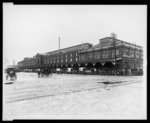
Center Market
Circa 1875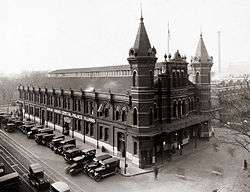 Center Market between 1910 and 1930
Center Market between 1910 and 1930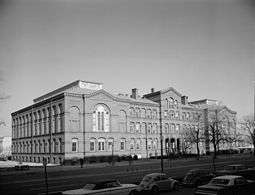 Army Medical Museum and Library
Army Medical Museum and Library
McMillan Plan
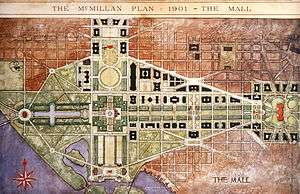
In 1902, the McMillan Commission's plan, which was partially inspired by the City Beautiful Movement and which purportedly extended L'Enfant's plan, called for a radical redesign of the Mall that would replace its greenhouses, gardens, trees, and commercial/industrial facilities with an open space.[9][22][35] The plan differed from L'Enfant's by replacing the 400 feet (120 m) wide "grand avenue" with a 300 feet (91 m) wide vista containing a long and broad expanse of grass.
Four rows of American elm trees (Ulmus americana) planted fifty feet apart between two paths or streets would line each side of the vista. Buildings housing cultural and educational institutions constructed in the Beaux-Arts style would line each outer path or street, on the opposite side of the path or street from the elms.[9][22][35][36][37][38]
In subsequent years, the vision of the McMillan plan was generally followed with the planting of American elms and the layout of four boulevards down the Mall, two on either side of a wide lawn.[36][39] In accordance with a plan that it completed in 1976, the NPS converted the two innermost boulevards (Washington and Adams Drives) into gravel walking paths.[36] The two outermost boulevards (Jefferson Drive Southwest (SW) and Madison Drive Northwest (NW)) remain paved and open to vehicular traffic.[36]
In 1918 contractors for the United States Navy's Bureau of Yards and Docks constructed the "Main Navy" and "Munitions" Buildings along nearly a third of a mile of the south side of Constitution Avenue (then known as B Street), from 17th Street NW to 21st Street NW.[40][42] Although the Navy intended the buildings to provide temporary quarters for the United States military during World War I, the reinforced concrete structures remained in place until 1970.[40] Much of the buildings' area then became Constitution Gardens, which was dedicated in 1976.[43]
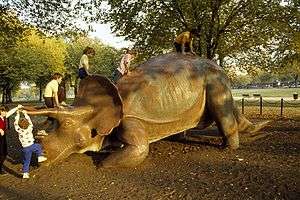
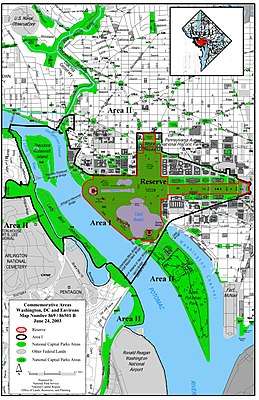
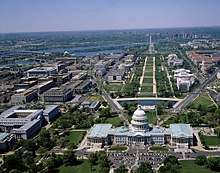
From the 1970s to 1994, a fiberglass model of a triceratops named "Uncle Beazley" stood on the Mall in front of the National Museum of Natural History. The life-size statue, which is now located at the National Zoological Park (the National Zoo) in Northwest Washington, D.C., was donated to the Smithsonian Institution by the Sinclair Oil Corporation. The statue, which Louis Paul Jonas created for Sinclair's DinoLand pavilion at the 1964 New York World's Fair, was named after a dinosaur in Oliver Butterworth's 1956 children's book, The Enormous Egg, and the 1968 televised movie adaptation in which the statue appeared.[44]
In 2003, the 108th United States Congress enacted the Commemorative Works Clarification and Revision Act. This Act prohibits the siting of new commemorative works and visitor centers in a designated reserve area within the cross-axis of the Mall.[45]
In October 2013, a two-week federal government shutdown closed the National Mall and its museums and monuments.[46] However, when a group of elderly veterans tried to enter the National World War II Memorial during the shutdown's first day, the memorial's barricades were removed.[47] The NPS subsequently announced that the veterans had a legal right to be in the memorial and would not be barred in the future.[48] During the shutdown's second week, the NPS permitted a controversial immigration rally and concert to take place on the Mall.[49]
On October 15, 1966, the NPS listed the National Mall on the National Register of Historic Places.[50] In 1981, the NPS prepared a National Register nomination form that documented the Mall's boundaries, features and historical significance.[6]
On December 8, 2016, the NPS listed on the National Register of Historic Places an increase in the National Mall Historic District's boundary to encompass an area bounded by 3rd Street, NW/SW, Independence Avenue, SW, Raoul Wallenberg Place, SW, the CSX Railroad, the Potomac River, Constitution Ave., NW, 17th Street, NW, the White House Grounds and 15th Street, NW. The listing's registration form, which contained 232 pages, described and illustrated the history and features of the historic district's proposed expanded area.[2]
Measurements
Dimensions
- Between the Capitol steps and the Lincoln Memorial, the Mall spans 1.9 miles (3.0 km).
- Between the Capitol steps and the Washington Monument, the Mall spans 1.2 miles (1.8 km).
- Between the Ulysses S. Grant Memorial and the Lincoln Memorial, the Mall covers 309.2 acres (125.13 ha).
- Between Constitution Avenue NW and Independence Avenue SW at 7th Street, the width of the Mall is 1,586 feet (483 m).
- Between Madison Drive NW and Jefferson Drive SW at 7th Street, the width of the Mall's open space is 656 feet (200 m).
- Between the innermost rows of trees near 7th Street, the width of the Mall's vista is 300 feet (91 m).
Boundaries
In its 1981 National Register of Historic Places nomination form, the NPS defined the boundaries of the National Mall (proper) as Constitution and Pennsylvania Avenues on the north, 1st Street NW on the east, Independence and Maryland Avenues on the south, and 14th Street NW on the west, with the exception of the section of land bordered by Jefferson Drive on the north, Independence Avenue on the south, and by 12th and 14th Streets respectively on the east and west, which the U.S. Department of Agriculture administers and which contains the Jamie L. Whitten Building (U.S. Department of Agriculture Administration Building).[6][51] A 2012-2016 NPS National Parks index describes the National Mall as being a landscaped park that extends from the Capitol to the Washington Monument, defined as a principal axis in the L'Enfant Plan for the city of Washington.[4]
However, a 2010 NPS plan for the Mall contains maps that show the Mall's general area to be larger.[52][53] A document within the plan describes this area as "the grounds of the U.S. Capitol west to the Potomac River, and from the Thomas Jefferson Memorial north to Constitution Avenue".[5] A map within the plan entitled "National Mall Areas" illustrates "The Mall" as being the green space bounded on the east by 3rd Street, on the west by 14th Street, on the north by Jefferson Drive, NW, and on the south by Madison Drive, SW.[54] A Central Intelligence Agency map shows the Mall as occupying the space between the Lincoln Memorial and the United States Capitol.[55]
In 2011, the 112th United States Congress enacted the Legislative Branch Appropriations Act, 2012, which transferred to the Architect of the Capitol the NPS "property which is bounded on the north by Pennsylvania Avenue Northwest, on the east by First Street Northwest and First Street Southwest, on the south by Maryland Avenue Southwest, and on the west by Third Street Southwest and Third Street Northwest".[56] This act removed Union Square (the area containing the Ulysses S. Grant Memorial and the Capitol Reflecting Pool) from NPS jurisdiction.[57]
Purposes
The National Park Service states that the purposes of the National Mall are to:
- Provide a monumental, dignified, and symbolic setting for the governmental structures, museums and national memorials as first delineated by the L'Enfant plan and further outlined in the McMillan plan.
- Maintain and provide for the use of the National Mall with its public promenades as a completed work of civic art, a designed historic landscape providing extraordinary vistas to symbols of the nation.
- Maintain National Mall commemorative works (memorials, monuments, statues, sites, gardens) that honor presidential legacies, distinguished public figures, ideas, events, and military and civilian sacrifices and contributions.
- Forever retain the West Potomac Park section of the National Mall as a public park for recreation and enjoyment of the people.
- Maintain the National Mall in the heart of the nation's capital as a stage for national events and a preeminent national civic space for public gatherings because it is here that the constitutional rights of speech and peaceful assembly find their fullest expression.
- Maintain the National Mall as an area free of commercial advertising while retaining the ability to recognize sponsors.[5]
Landmarks, museums, and other features
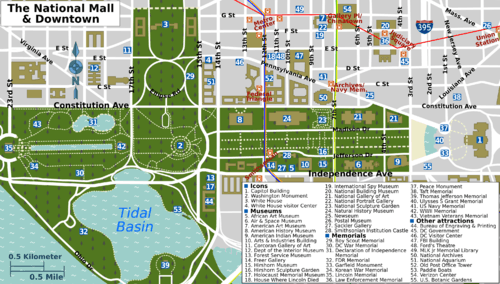
Features within the National Mall proper
_satellite_image.jpg)
The National Mall proper contains the following landmarks, museums and other features (including opening year):[5][6]
|
2. National Museum of American History (1964)[58] |
10. National Museum of the American Indian (2004) |
14. Smithsonian Institution Building ("The Castle") (1849) |
Not marked on the above image:
- Above the Smithsonian Institution Building
- Joseph Henry statue[59]
- Below the Smithsonian Institution Building
- Andrew Jackson Downing Urn[60]
- Above the Arts and Industries Building
- Smithsonian Carousel[61]

With the exception of the National Gallery of Art, all of the museums on the National Mall proper are part of the Smithsonian Institution. The Smithsonian Gardens maintains a number of gardens and landscapes near its museums.[62] These include:
- Common Ground: Our American Garden[63]
- Enid A. Haupt Garden[64]
- Freer Gallery of Art Courtyard Garden[65]
- Hirshhorn Museum and Sculpture Garden[66]
- Kathrine Dulin Folger Rose Garden[67]
- Mary Livingston Ripley Garden[68]
- National Air and Space Museum landscape[69]
- Native landscape at the National Museum of the American Indian[70]
- Pollinator Garden[71]
- Urban Bird Habitat[72]
- Victory Garden[73]
Features east of the National Mall proper
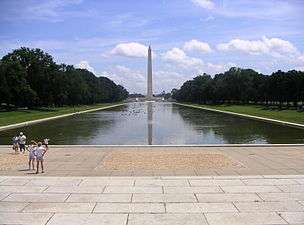
Features east of the National Mall proper include:
- United States Capitol and its grounds (no. 7 on image)
- Union Square, containing:
- Capitol Reflecting Pool (no. 8 on image)
- Ulysses S. Grant Memorial (east of no. 8 on image)
- Peace Monument (in traffic circle northeast of no. 8 in image)
- United States Botanic Garden (no. 9 on image)
- James A. Garfield Monument (in traffic circle northeast of no. 9 in image)
Features west of the National Mall proper
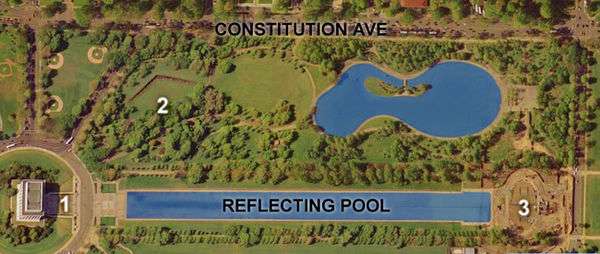
- Lincoln Memorial
- Vietnam Veterans Memorial, The Three Soldiers statue, and Vietnam Women's Memorial
- National World War II Memorial (shown under construction)
Not marked on the above image:
- Above the Lincoln Memorial Reflecting Pool (marked as Reflecting Pool):
- Upper right corner below Constitution Avenue:
Outside of the above image:

- To the right of the construction site of the National World War II Memorial:
- Washington Monument and its grounds (number 1 in image of National Mall proper and adjacent areas), including:
- Between the Washington Monument and the National Museum of American History (between numbers 1 and 2 in image of National Mall proper and adjacent areas):
- Site of present National Museum of African American History and Culture
- Below the Lincoln Memorial:
- John Ericsson National Memorial
- Below the Lincoln Memorial Reflecting Pool:
- Below the lower right corner:
American elm trees

The planting of American elm trees on the National Mall in accordance with the McMillan Plan started in the 1930s between 3rd and 14th Streets at the same time that Dutch Elm Disease (DED) began to appear in the United States. Concern was expressed about the potential consequences that DED could have on these trees. Nevertheless, the population of American elms planted on the Mall and its surrounding areas has remained intact for the past 80 years because of disease management and immediate tree replacement.[74]
DED first appeared on the Mall during the 1950s and reached a peak in the 1970s. The NPS has used a number of methods to control this fungal epidemic, including sanitation, pruning, injecting trees with fungicide and replanting with DED-resistant American elm cultivars (see Ulmus americana cultivars). The NPS has combated the disease's local insect vector, the smaller European elm bark beetle (Scolytus multistriatus), by trapping and by spraying with insecticides. Soil compaction and root damage by crowds and construction projects also adversely affect the elms.[74]
Demolished or moved structures
- Washington City Canal, covered over by Constitution Avenue NW, 3rd Street NW and SW and Canal Street SW (now Washington Street SW).
- Baltimore and Potomac Railroad Station closed in 1907 when Union Station opened.
- United States Department of Agriculture Building, razed in 1930.
- Center Market replaced in 1931 by the National Archives Building.
- Armory Square Hospital/Armory replaced in 1964 by the National Air and Space Museum.
- Army Medical Museum and Library, demolished in 1968; replaced by the Hirshhorn Museum
- Uncle Beazley moved in 1994 to the National Zoo.
Other attractions nearby
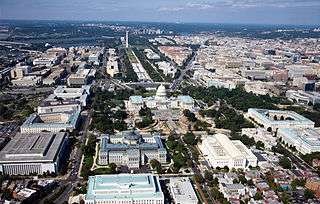
Other attractions within walking distance of the National Mall (proper) include:
Attractions east of the Capitol:
Attractions northeast of the National Mall (proper):
- National Postal Museum
- Union Station
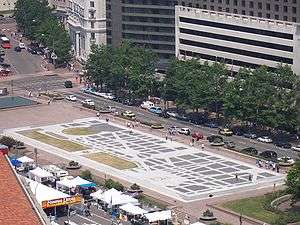
Attractions north of the National Mall (proper):
- National Archives
- The Freedom Forum's Newseum
- Old Post Office Building and Clock Tower
- Inlay of L'Enfant's plan for the federal capital city in Freedom Plaza
- National Theatre
- Ford's Theatre
Attractions northwest of the National Mall (proper):
- White House (on a line directly north of the Washington Monument)
- The Ellipse
- Albert Einstein Memorial
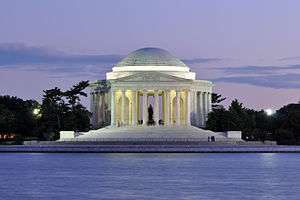
Attractions south of the National Mall (proper):
Attractions southwest of the National Mall (proper):
Usage
The National Mall, in combination with the other attractions in the Washington Metropolitan Area, makes the nation's capital city one of the most popular tourist destinations in the country. It has several other uses in addition to serving as a tourist focal point.
Protests and rallies

The National Mall's status as a wide, open expanse at the heart of the capital makes it an attractive site for protests and rallies of all types. One notable example is the 1963 March on Washington for Jobs and Freedom, a political rally during the Civil Rights Movement, at which Martin Luther King Jr. delivered his speech "I Have a Dream".
The largest officially recorded rally was the Vietnam War Moratorium Rally on October 15, 1969. However, in 1995, the NPS issued a crowd estimate for the Million Man March with which an organizer of the event, Nation of Islam leader Louis Farrakhan, disagreed.[75][76] The next year, a committee of the 104th United States Congress provided no funds for NPS crowd-counting activities in Washington, D.C. when it prepared legislation making 1997 appropriations for the U.S. Department of the Interior.[75][77]
As a result, the NPS has not provided any official crowd size estimates for Mall events since 1995.[75][78][79][80] The absence of such an official estimate fueled a political controversy following the presidential inauguration of Donald Trump in 2017 (see: Inauguration of Donald Trump crowd size).[81][82]
On April 25, 2004, the March for Women's Lives filled the Mall.[83] On January 27, 2007, tens of thousands of protesters opposed to the Iraq War converged on the Mall (see: January 27, 2007 anti-war protest), drawing comparisons by participants to the Vietnam War protest.[84][85]
On June 12, 2018, the National Hockey League's Washington Capitals staged a rally on the Mall after parading through the city to celebrate the franchise's first Stanley Cup championship victory. Tens of thousands of fans reportedly joined the beer-soaked event.[86]
Presidential inaugurations
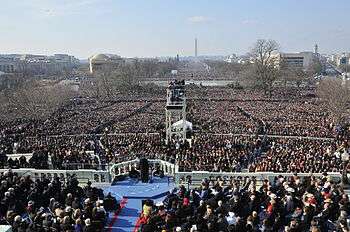
During presidential inaugurations, people without official tickets gather at the National Mall. Normally, the Mall between 7th and 14th Streets NW is used as a staging ground for the parade.[87] On December 4, 2008, the Presidential Inaugural Committee (see: United States presidential inauguration organizers) announced, "for the first time, the entire length of the National Mall will be opened to the public so that more people than ever before will be able to witness the swearing-in of the president from a vantage point in sight of the Capitol."[88] The Committee made this arrangement because of the massive attendance – projected to be as many as 2 million people – that it expected for the first inauguration of Barack Obama on January 20, 2009.
Despite the arrangement, a throng of people seeking access to the event climbed and then removed temporary protective fences around the Smithsonian's Mary Livingston Ripley Garden, six blocks from the site at which Obama took his inaugural oath. Hordes then trampled the garden's vegetation and elevated plant beds when entering and leaving the event.[89] Others could not find a way to enter the Mall in time to view the ceremony.
More than a thousand people with tickets missed the event while being stranded in the I-395 Third Street Tunnel beneath the Mall after police directed them there (see Purple Tunnel of Doom).[90] The Joint Congressional Committee on Inaugural Ceremonies subsequently announced that ticket holders that were not admitted would receive copies of the swearing-in invitation and program, photos of Obama and Vice President Joe Biden, and a color print of the ceremony.[91]
Other events and recreational activities
The National Mall has long served as a spot for jogging, picnics, and light recreation for the Washington population. The Smithsonian Carousel, located on the Mall in front of the Arts and Industry Building, is a popular attraction that operates seasonally.[92] The carousel was built by the Allan Herschell Company and arrived at Gwynn Oak Park near Baltimore, Maryland, in 1947. It was moved to the Mall in 1981.[61]
Annual events
A number of large free events recur annually on the Mall.[93] A kite festival, formerly named the "Smithsonian Kite Festival" and now named the "Blossom Kite Festival", usually takes place each year on the Washington Monument grounds during the last weekend of March as part of the National Cherry Blossom Festival. The event's organizers cancelled the 2020 kite festival, which they had earlier scheduled to take place on the Washington Monument grounds on Saturday, March 28, because of concerns related the ongoing coronavirus pandemic.[94]

An Earth Day celebration often takes place on the Mall around April 22.[95] A week-long series of rallies, exhibits, observances and performances occurred on the Mall from April 17 to April 25, 2010 to commemorate Earth Day's 40th anniversary.[96] The final day's events featured performances by Sting, Mavis Staples, The Roots, John Legend and others.[97] The 2012 Earth Day rally, which featured music, entertainment, celebrity speakers and environmental activities, took place on the Mall during a rainy day on Sunday, April 22. Cheap Trick, Dave Mason, Kicking Daisies, Sting, John Legend, Joss Stone, The Roots, Mavis Staples, Jimmy Cliff, Bob Weir and The Explorers Club performed and Congressmen John Dingell and Edward Markey spoke.[98] In 2013, an "Earth Month" at Washington's Union Station replaced the Mall's Earth Day event.[99] On April 19, 2015, a "Global Citizen" Earth Day concert featured performances on the Washington Monument grounds by Usher, My Morning Jacket, Mary J. Blige, Train and No Doubt.[100]
The National Symphony Orchestra presents each year its National Memorial Day Concert on the west lawn of the United States Capitol during the evening of the Sunday before Memorial Day (the last Monday of May).[101] The National Gallery of Art hosts a Jazz in the Garden series each year in the museum's Sculpture Garden on Friday evenings from late May through August.[102]
Components of the United States Navy Band, the United States Air Force Band, the United States Marine Band and the United States Army Band perform on the west steps of the United States Capitol on Monday, Tuesday, Wednesday and Friday evenings, respectively, during June, July and August.[103][104] The Marine Band repeats each Wednesday Capitol performance on the following evening (Thursday) at the Sylvan Theater on the grounds of the Washington Monument.[104] Components of U.S. military bands also provide evening concerts at the World War II Memorial from May through August.[105]
The Smithsonian Folklife Festival takes place on the Mall each year for two weeks around Independence Day (July 4).[106][107] On that holiday, the A Capitol Fourth concert takes place in the late afternoon and early evening on the west lawn of the Capitol.[108] This and other Independence Day celebrations on and near the Mall end after sunset with a fireworks display between the Washington Monument and the Lincoln Memorial.[109]
The National Symphony Orchestra presents each year its Labor Day Capitol Concert on the west lawn of the United States Capitol during the evening of the Sunday before Labor Day (the first Monday of September).[110]
Other events
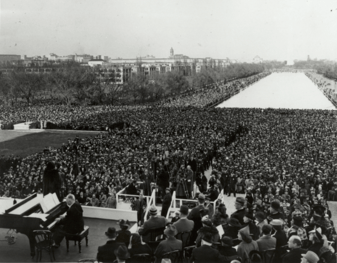
On April 9, 1939, singer Marian Anderson gave an Easter Sunday concert at the Lincoln Memorial after the Daughters of the American Revolution (DAR) denied a request by Howard University for her to give an Easter performance at the DAR's nearby racially segregated Constitution Hall (see: Marian Anderson's 1939 Lincoln Memorial concert). The event, which 75,000 people attended, occurred after President Franklin D. Roosevelt gave his assent for the performance.[111][112]
The 1976 United States Bicentennial celebration provided the motivation for planning to accommodate large numbers of expected visitors to the National Mall. A number of major memorials were added to the Mall throughout that period.[113] On May 21, 1976, Constitution Gardens was dedicated.[114] On July 1, the Smithsonian National Air and Space Museum opened.[115] On July 4, the Bicentennial fireworks display on the Mall attracted one million viewers, making it second only to the 1965 presidential inauguration of Lyndon B. Johnson as the largest event in the Mall's history up to that time.[116]
On Sunday, October 9, 1979, Pope John Paul II celebrated Mass on the National Mall during a visit to Washington.[117] The celebration took place after an appellate court denied a motion for an injunction that atheists Madalyn Murray O'Hair and Jon Garth Murray had filed to prevent the event from occurring.[118]
From 1980 through 1982, The Beach Boys and The Grass Roots performed Independence Day concerts on the Mall, attracting large crowds.[119][120][121] However, in April 1983, Secretary of the Interior James G. Watt, banned Independence Day concerts on the Mall by such groups. Watt said that "rock bands" that had performed on the Mall on Independence Day in 1981 and 1982 had encouraged drug use and alcoholism and had attracted "the wrong element", who would mug individuals and families attending any similar events in the future.[120] Watt then announced that Las Vegas crooner Wayne Newton, a friend and supporter of President Reagan and a contributor to Republican Party political campaigns, would perform at the Mall's 1983 Independence Day celebration.[120][122]
During the ensuing uproar, Rob Grill, lead singer of The Grass Roots, stated that he felt "highly insulted" by Watt's remarks, which he called "nothing but un-American".[120] The Beach Boys stated that the Soviet Union, which had invited them to perform in Leningrad in 1978, "obviously .... did not feel that the group attracted the wrong element".[120] Vice President George H. W. Bush said of The Beach Boys, "They're my friends and I like their music".[120] On July 3, 1983, thousands attended a heavily policed "Rock Against Reagan" concert that the hardcore punk rock band, Dead Kennedys, performed on the Mall in response to Watt's action.[123] When Newton entered an Independence Day stage on the Mall on July 4, members of his audience booed.[124][125] Watt apologized to The Beach Boys, First Lady Nancy Reagan apologized for Watt, and in 1984 The Beach Boys gave an Independence Day concert on the Mall to an audience of 750,000 people.[124][126]
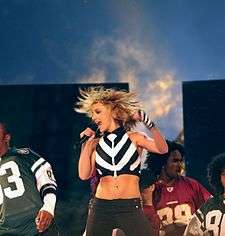
On September 4, 2003, Britney Spears, Mary J. Blige, Aretha Franklin, Aerosmith and others performed in a nationally televised "NFL Kickoff Live from the National Mall Presented by Pepsi Vanilla" (see: Pre-game concerts for National Football League kickoff game).[127] Preceded by a three-day National Football League "interactive Super Bowl theme park", the event had primarily commercial purposes, unlike earlier major activities on the Mall. Three weeks later, the United States Senate overwhelmingly passed legislation that, when enacted into law, limited displays of commercial sponsorship on the Mall.[128]
On July 7, 2007, one leg of Live Earth was held outdoors at the National Museum of the American Indian on the Mall. Former vice president Al Gore presented, and artists such as Garth Brooks and Trisha Yearwood performed.[129]
Occurring once every two to three years on the Mall in the early fall from 2002 to 2009,[130] the U.S. Department of Energy Solar Decathlon displayed solar-powered houses that competitive collegiate teams designed, constructed and operated.[131][132] Igniting a controversy, the Department of Energy (DOE) decided to move the 2011 Decathlon off the Mall, claiming that this would support an effort to protect, improve and restore the park.[133] Federal officials stated that heavy equipment that had placed two-story houses on the Mall during earlier Decathlons had cracked walkways and killed grass to a greater extent than had most other Mall events.[134]
On February 4, 2011, a Washington Post editorial criticized attempts to have President Obama restore the Decathlon to the Mall.[135] Nevertheless, by February 12, 2011, at least thirteen U.S. senators had signed a letter asking the DOE to reconsider its decision.[134] On February 23, 2011, the DOE and the Department of the Interior announced that the 2011 Solar Decathlon would take place along Ohio Drive southeast of the Franklin Delano Roosevelt Memorial in West Potomac Park.[136] The event took place in the Park from September 23 through October 2, 2011.[132][137] The 2013 Decathlon took place in California instead of Washington.[138]
From 2003 to 2013, the National Book Festival took place on the Mall each year in late September or early October.[139] However, the event moved to the Walter E. Washington Convention Center in 2014 because the NPS became concerned about the damage that pedestrians had inflicted on the Mall's lawn during previous Festivals.[140]
A four-day exhibition took place each year on the Mall during Public Service Recognition Week (the first full week of May) until 2010. Government agencies participating in the event sponsored exhibits that displayed the works of public employees and that enabled visitors to learn about government programs and initiatives, discuss employee benefits, and interact with agency representatives.[141] However, the 2011 United States federal budget (Public Law 112-10), which was belatedly enacted on April 15, 2011, contained no funding for that year's event, forcing the event's cancellation.[142] The event did not take place in 2012.[143]
On June 12, 2010, Tareq and Michaele Salahi, a couple under investigation for allegedly crashing a White House state dinner for the prime minister of India in November 2009 (see: 2009 U.S. state dinner security breaches), hosted an America's Polo Cup match between the United States and India on the Mall. The advertised ticket price for this event was $95 per person.[144] Reports of the event stated that the players who represented India were actually of Pakistani origin and were from Florida.[145] A spokesman for the Embassy of India stated that neither the Embassy nor the government of India had any association with the event.[144] The event's website reportedly identified an Indian company, Kingfisher Beer, as a sponsor. However, Kingfishers' chief executive denied that the company had sponsored the event.[144] Yashpal Singh, the president and chief executive of Mendocino Brewing Company, Kingfisher's parent company, stated, "We are not sponsoring this event and have informed the people managing this event of that, .... We have sent legal notices to this effect, and he keeps on advertising us as a sponsor. I don't know what world he's living in."[144]

The inaugural USA Science and Engineering Festival Expo took place on the National Mall and surrounding areas on October 23 and 24, 2010. More than 1,500 free interactive exhibits reportedly drew about 500,000 people to the event,[146] which had over 75 performances.[147] The second Expo took place on April 28–29, 2012, in the Walter E. Washington Convention Center.[148]
On Veterans Day, November 11, 2014, Bruce Springsteen, Eminem, Rihanna, Metallica, Carrie Underwood, Dave Grohl, the Zac Brown Band and other pop entertainers performed on the Mall during a free evening Concert for Valor honoring veterans and their families. Attendance was in the hundreds of thousands, making it one of the biggest events on the Mall for the year.[149]
The annual Screen on the Green movie festival took place on the Mall on Monday nights during July and August for 17 years until 2015. Free classic movies were projected on large portable screens and typically drew crowds of thousands of people. Organizers cancelled the event in 2016 when the event's sponsors (HBO and Comcast) terminated their support, stating that they needed their resources for other projects.[150]
Improvements and future plans
National Mall Plan
From 2006 through 2010, the NPS conducted a public process that created a plan for the future of the National Mall.[52] On July 13, 2010, the NPS issued in the Federal Register a notice of availability of a final environmental impact statement (EIS) for the National Mall Plan.[151] The two-volume final EIS responded to comments and incorporated changes to a draft EIS for the Plan.[152]
On November 9, 2010, the NPS and the Department of the Interior issued a Record of Decision (ROD) that completed the planning process.[52][153][154][155] The ROD contains a summary of the selected alternative, which is the basis for the Plan, together with mitigation measures developed to minimize environmental harm; other alternatives considered; the basis for the decision in terms of planning objectives and the criteria used to develop the preferred alternative; a finding of no impairment of park resources and values; the environmentally preferable alternative; and the public and agency involvement.[156][157]
The Plan proposed a number of changes to the Mall. The NPS would construct at the east end of the Mall a wide expanse of paved surface in Union Square to accommodate demonstrations and other events by reducing the size of the Capitol Reflecting Pool or by replacing the pool with a fountain or other small water feature. Additional proposed changes included the replacement of the Sylvan Theater on the Washington Monument grounds with a facility containing offices, restaurants and restrooms, as well as the replacement of an open space near the east end of Constitution Gardens with a multipurpose visitor facility containing food service, retail, and restrooms.[52][153][154][155]
On December 2, 2010, the National Capital Planning Commission (NCPC) unanimously approved the final National Mall Plan at a public hearing.[158] The NCPC's approval allowed the NPS to move forward with implementation of the Plan's recommendations.[52][155][156][158]
On March 1, 2012, the NCPC discussed a proposal that, when implemented, reduced the Mall's green space by widening and paving most of the north-south walkways that cross the Mall between Seventh and Fourteenth Streets. The project also replaced with gravel large areas of grass that were located near the Smithsonian Metro Station and the National Gallery of Art's Sculpture Garden.[159]
On September 8, 2011, the Trust for the National Mall[160] and the NPS announced an open competition for a redesign of the spaces on the National Mall that Union Square, the Sylvan Theater grounds and the Constitution Gardens lake now occupy.[161] Former first lady of the United States Laura Bush agreed to be the honorary co-chair of a drive to raise funds for the three projects.[161]
On April 9, 2012, the Trust for the National Mall announced the ideas for the redesign of Union Square, the Sylvan Theater grounds and Constitution Gardens lake area that finalists in the competition had submitted. The Trust asked the public to submit online comments that the competition jury would consider when evaluating each design.[162] The Trust announced the winners of the competition on May 2, 2012. Groundbreaking for the first project was expected to take place by 2014, with the first ribbon-cutting ceremony by 2016.[163]
On October 1, 2015, the NCPC approved preliminary and final site and building plans that the NPS had submitted for the first phase rehabilitation of Constitution Gardens. Plans included the relocation and rehabilitation of the Lockkeeper's House, C & O Canal Extension, a new entry plaza at the corner of Constitution Avenue and 17th Street, NW, landscaping, a meadow and pollinator habitat and a new perimeter garden wall. A temporary path would connect to an existing plaza located at the eastern end of Constitution Garden's lake.[164]
The NPS began to implement the first phase rehabilitation of Constitution Gardens in 2017. A Park Service contractor moved the Lockkeeper's House, C & O Canal Extension, southward and westward away from Constitution Avenue, NW and 17th Street, NW while retaining the structure's east-west orientation.[18][165] The NPS restored the building's exterior to the conditions that had existed before the building was modified during 1915 and earlier years. The NPS also replaced the structure's brick chimneys, thus restoring the building to its original 1800s appearance. The building reopened temporarily in late August 2018 and permanently on September 13 of that year.[17][18][166] The structure now serves in its new location as an NPS education center.[17][18]
Reconstruction and restoration
From 2010 to 2012, NPS contractors rebuilt the aging Lincoln Memorial Reflecting Pool, which had first been constructed in the early 1920s and whose water had come from the pipes that supply Washington, D.C., with its drinking water. As a result of the project, the pool now receives filtered water from the Tidal Basin through a high-density polyethylene (HDPE) pipeline.[167]
The NPS then began a four-year restoration of the portion of the central axis of the Mall that lies between 3rd Street and 14th Street.[168] By 2016, the restoration project had completely replaced the deteriorated and weedy turf that had previously covered much of that part of the Mall with a new cover containing soil, fescue (Festuca) and Kentucky bluegrass (Poa pratensis).[169]
.jpg) Lincoln Memorial Reflecting Pool before reconstruction (April 2010)
Lincoln Memorial Reflecting Pool before reconstruction (April 2010) Lincoln Memorial Reflecting Pool undergoing reconstruction (June 2011)
Lincoln Memorial Reflecting Pool undergoing reconstruction (June 2011)- Lincoln Memorial Reflecting Pool undergoing reconstruction (December 2011)
 Lincoln Memorial Reflecting Pool after reconstruction (May 2016)
Lincoln Memorial Reflecting Pool after reconstruction (May 2016)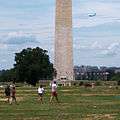 Axis of National Mall before restoration (July 2012)
Axis of National Mall before restoration (July 2012) Axis of National Mall undergoing restoration (October 2015)
Axis of National Mall undergoing restoration (October 2015) Axis of National Mall after restoration (September 2016)
Axis of National Mall after restoration (September 2016)
Transportation
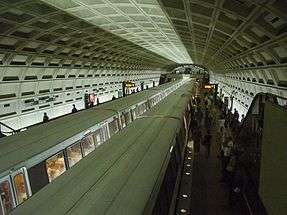
Public transportation
The National Mall is accessible via the Washington Metro, with the Smithsonian station located on the south side of the Mall, near the Smithsonian Institution Building between the Washington Monument and the United States Capitol.[170] The Federal Triangle, Archives, and Union Station Metro stations are also located near the Mall, to the north.[171] The L'Enfant Plaza, Federal Center Southwest and Capitol South Metro stations are located several blocks south of the Mall.[172] Metrobus and the DC Circulator make scheduled stops near the Mall.[173]
Bicycles
The NPS provides parking facilities for bicycles near each of the major memorials as well as along the National Mall.[174] From March to October, an NPS concessionaire rents out bicycles at the Thompson Boat Center, located near the intersection of Virginia Avenue NW and Rock Creek and Potomac Parkway, 1 mile (1.6 km) north of the Lincoln Memorial along the Potomac River-Rock Creek Trail.[174][175] The first two of five approved Capital Bikeshare stations opened on the National Mall on March 16, 2012, shortly before the start of the 2012 National Cherry Blossom Festival.[176]
The National Mall is the official midpoint of the East Coast Greenway, a 2,900 mile–long system of shared-use bicycle trails linking Calais, Maine, with Key West, Florida.[177]
Electric scooters and Segways
The use of an electric scooter or a Segway falls under the NPS definition of a recreational use of a self-propelled vehicle. People without identified disabilities can only use such vehicles on park roadways. NPS rules therefore prohibit people without disabilities from using electric scooters and Segways on sidewalks and paths within the National Mall and its memorials.[178][179]
Several companies rent out electric scooters within the District of Columbia. However, the National Mall is outside of those companies' service areas. Some such companies therefore charge fines for people who end their rides on the Mall. Others do not allow people to end their trips until they have left the area.[179]
Pedicabs
The NPS licenses pedicab drivers to provide transportation and tours of the National Mall through its Commercial Use Authorization program.[180]
Motor vehicle parking
General visitor parking is available along Ohio Drive SW, between the Lincoln and Thomas Jefferson Memorials. Bus parking is available primarily along Ohio Drive, SW, near the Lincoln and Thomas Jefferson Memorials and along Ohio Drive SW, in East Potomac Park. There is limited handicapped parking at the Franklin Delano Roosevelt and World War II Memorials and near the Washington Monument and the Thomas Jefferson, Lincoln, Korean War Veterans, and Vietnam Veterans Memorials; otherwise, parking is extremely scarce in and near the Mall.[181]
In April 2017, the NPS awarded a contract for the installation of parking meters on streets and in parking areas on the Mall. On June 12, 2017, the NPS and the District of Columbia Department of Public Works began to enforce metered parking on approximately 1,100 parking spaces in which motorists could previously park without charge.[181][182]
Climate
| ||||||||||||||||||||||||||||||||||||||||||||||||||||||||||||||||||||||||||||||||||||||||||||||||||||||||||||||||||||||||||||
See also
- National Register of Historic Places listings in Washington, D.C.
- Operation Fast Forward
- Capitol Mall, a similar but smaller parkway situated in front of California State Capitol modeled on the National Mall
References
- "National Register of Historic Places: NPS Focus". National Park Service. Retrieved July 8, 2010. Archived July 25, 2008, at the Wayback Machine.
- "District of Columbia: National Mall Historic District (Boundary Increase and Additional Documentation), Bounded by 3rd St. NW-SW, Independence Ave. SW, Raoul Wallenberg Pl. SW, CSX RR, Potomac R., Constitution Ave. NW, Washington, 16000805, Listed 12/8/2016". National Register of Historic Places Program: Weekly List of Actions Taken on Properties: 11/28/2016 through 12/2/2016. National Park Service. December 9, 2016. Archived from the original on December 20, 2016. Retrieved December 20, 2016.
- Robinson, Judith H.; Gasparini, Daria; Kerr, Tim (Robinson & Associates, Inc., Washington, D.C.) (May 31, 2016). "National Mall Historic District – Boundary Increase/Additional Documentation (Final backcheck)". United States Department of the Interior: National Park Service: National Register of Historic Places Registration Form. National Park Service. Archived from the original on October 12, 2016. Retrieved October 12, 2016.
- "The National Parks: Index 2012-2016" (PDF). National Park Service. p. 44. Archived from the original (PDF) on December 26, 2017. Retrieved December 26, 2017.
- "Foundation statement for the National Mall and Pennsylvania Avenue National Historic Park" (PDF). National Mall Plan. National Park Service. pp. 6–10. Retrieved December 26, 2017.
The National Mall stretches from the grounds of the U.S. Capitol west to the Potomac River, and from the Thomas Jefferson Memorial north to Constitution Avenue.
Archived December 26, 2017, at the Wayback Machine. - Pfanz, Donald C. (February 11, 1981). "National Register of Historic Places Inventory Nomination Form: National Mall" (PDF). National Park Service. Archived from the original on December 23, 2015. Retrieved March 17, 2010.
- "National Mall Frequently Asked Questions". National Park Service. October 28, 2008. Archived from the original on May 7, 2010. Retrieved April 18, 2010.
- Pfanz, Donald C. (February 11, 1981). "National Register of Historic Places Inventory — Nomination Form: National Mall" (PDF). National Park Service. Archived from the original on December 23, 2015. Retrieved March 17, 2010.
- Sherald, James L (December 2009). Elms for the Monumental Core: History and Management Plan (PDF). Washington, D.C.: Center for Urban Ecology, National Capital Region, National Park Service. pp. 2–5. Natural Resource Report NPS/NCR/NRR--2009/001. Retrieved October 14, 2010. Archived 2010-11-29 at the Wayback Machine.
- (1) "Map 1: The L'Enfant Plan for Washington". National Park Service. Archived from the original on January 21, 2009. Retrieved October 27, 2009.
(2) L'Enfant identified himself as "Peter Charles L'Enfant" during most of his life, while residing in the United States. He wrote this name on his "Plan of the city intended for the permanent seat of the government of t(he) United States ...." (Washington, D.C.) and on other legal documents. However, during the early 1900s, a French ambassador to the United States, Jean Jules Jusserand, popularized the use of L'Enfant's birth name, "Pierre Charles L'Enfant". (See: Bowling, Kenneth R (2002). Peter Charles L'Enfant: vision, honor, and male friendship in the early American Republic. George Washington University, Washington, D.C.) The National Park Service identifies L'Enfant as Major Peter Charles L'Enfant Archived 2014-04-05 at the Wayback Machine and as Major Pierre (Peter) Charles L'Enfant Archived 2010-02-28 at the Wayback Machine on its website. The United States Code states in 40 U.S.C. § 3309: "(a) In General.—The purposes of this chapter shall be carried out in the District of Columbia as nearly as may be practicable in harmony with the plan of Peter Charles L'Enfant." - (1) Portion of Mathew Carey's 1802 map of Washington City showing the Mall In Hanlon, Mary. "The Mall: The Grand Avenue, The Government, and The People". University of Virginia. Archived from the original on July 28, 1997. Retrieved July 3, 2019.
Mathew Carey's 1802 map was the first one to name the stretch of land west of the Capitol as "The Mall."
(2) Draper, I. (1802). "Washington City". Philadelphia: Mathew Carey. Archived from the original (map) on March 12, 2012. Retrieved February 3, 2015. In "A Washington Map Chronology". dcsymbols.com.Mathew Carey's 1802 map was the first one to name the stretch of land west of the Capitol as "The Mall."
Cite journal requires|journal=(help)
(3) Glazer, Nathan; Field, Cynthia R., eds. (2008). "A Chronology of the Mall". The National Mall: Rethinking Washington's Monumental Core. Baltimore, Maryland: The Johns Hopkins University Press. p. 179. ISBN 978-0-8018-8805-2. OCLC 166273738. Retrieved July 3, 2019 – via Google Books.1802: Mathew Carey's map of Washington is the first to name the stretch of land west of the Capitol as "The Mall".
Archived July 3, 2019, at the Wayback Machine.
(4) Moore, S.S.; Jones, T.W. (1802). "Washington City". The Traveller's Directory (enlarged copy of map). Philadelphia: Mathew Carey. Retrieved July 3, 2019 – via Library of Congress online catalog.
(5) Carey, Mathew (1802). Washington City. Carey's General Atlas... Philadelphia. p. 23. LCCN unk81034134. Retrieved July 3, 2019 – via Library of Congress online catalog. - (1) "Why is this space called a "Mall"?". Histories of the National Mall. Fairfax County, Virginia: Roy Rosenzweig Center for History and New Media, George Mason University. Archived from the original on July 2, 2019. Retrieved July 2, 2019.
(2) Walford, Edward (1887–93). "Chapter VII: The Mall and Spring Gardens". Old and New London: A Narrative of Its History, its People, and its Places. 4: Westminster and the Western Suburbs (New ed.). London, England: Cassell & Company, Limited. pp. 74–85. OCLC 35291703. Retrieved July 2, 2019 – via HathiTrust Digital Library.CS1 maint: date format (link) - Williams, Paul K. (October 28, 2013). "The ill fated Washington City Canal: filled in and paved over in 1871". The House History Man. Retrieved June 19, 2018 – via Blogger. Archived September 9, 2016, at the Wayback Machine.
- Bryan, Wilhelmus Bogart (1916). "Chapter IV. Erection of the City Hall". A History of the National Capital from Its Foundation Through the Period of the Adoption of the Organic Act, Volume 2. New York: MacMillan. p. 104. Retrieved October 8, 2009 – via Google Books. Archived May 29, 2016, at the Wayback Machine.
- Pfingsten, Bill (ed.). ""Lock Keeper's House" marker". HMdb.org: The Historical Marker Database. Retrieved December 17, 2018. Archived December 17, 2018, at the Wayback Machine.
- Robarge, Drew (March 28, 2011). "Washington, D.C.'s 19th Century Reclamation Project". Technology. The Atlantic. Retrieved December 18, 2018. Archived August 18, 2018, at the Wayback Machine.
- "Come see the restored Lockkeeper's House". Lockkeeper's House. Washington, D.C.: Trust for the National Mall. Archived from the original on April 4, 2019. Retrieved January 17, 2020.
The Lockkeeper's House — the oldest structure on the National Mall — has been relocated and restored as part of a major project that has transformed the site with a new visitor-friendly entrance, surrounding outdoor plaza and educational displays.
Previously located just inches from heavy traffic at the corner of 17th Street and Constitution Avenue NW, the house was lifted and moved about 20 feet from the road. Untouched for more than 40 years, the 180-year old structure now welcomes visitors from around the world to the National Mall. - (1) Weiner, Talia (July 5, 2018). "181-Year-Old Lockkeeper's Tiny House Ready For Its Next Chapter". NPR. Retrieved December 17, 2018. Archived July 18, 2018, at the Wayback Machine.
(2) "Historic Lockkeeper's House Opens on the National Mall Following Major Renovation". Washington, D.C.: Trust for the National Mall. October 23, 2018. Retrieved January 17, 2020. Archived January 17, 2020, at the Wayback Machine. - Morton, W. Brown III (February 8, 1971). "National Register of Historic Places Inventory — Nomination Form: Smithsonian Institution Building". United States Department of the Interior: National Park Service. Retrieved July 21, 2018. Archived August 30, 2018, at the Wayback Machine.
- Torres, Louis (1985). "To the immortal name and memory of George Washington": The United States Army Corps of Engineers and the Construction of the Washington Monument (PDF). United States Government Printing Office. p. 17. LCCN 85601652. OCLC 12085597. Retrieved July 21, 2018. Archived June 24, 2016, at the Wayback Machine.
- Portion of "Map of Washington, D.C." Buffalo, New York: The Matthews-Northrup Company. 1893. Retrieved December 20, 2018 – via Library of Congress. Archived December 20, 2018, at the Wayback Machine.
- Hanlon, Mary. "The Mall: The Grand Avenue, The Government, and The People". University of Virginia. Retrieved July 3, 2019. Archived June 5, 2011, at the Wayback Machine.
- (1) Schuyler, David (February 2000). "Downing, Andrew Jackson". American Council of Learned Societies: American National Biography Online. Oxford University Press. Retrieved September 18, 2017.
In late 1850 Downing was commissioned to landscape the public grounds in Washington, D.C. This 150-acre tract extended west from the foot of Capitol Hill to the site of the Washington Monument and then north to the president's house. Downing saw this as an opportunity not simply to ornament the capital but also to create the first large public park in the United States. He believed that the Washington park would encourage cities across the nation to provide healthful recreational grounds for their citizens. Although only the initial stages of construction had been completed at the time of his death, Downing's commission, as well as the influence of his writings, merited the epithet "Father of American Parks".
Archived September 18, 2017, at the Wayback Machine.
(2) "Downing's Plans for the Mall". Smithsonian Gardens: The Downing Urn. Smithsonian Institution. Retrieved June 13, 2020. Archived March 16, 2020, at the Wayback Machine.
(3) "Andrew Jackson Downing's Plan for the National Mall: Plan Showing Proposed Laying Out of the Public Grounds at Washington: Copied from the Original Plan by A. J. Downing: February. 1851. To Accompany the Annual Report dated October 1st, 1867, of Bvt Brig. Genl. N. Michler In Charge of Public Buildings, Grounds & Works". National Archives. Retrieved September 17, 2017. Archived September 17, 2017, at the Wayback Machine.
(4) Fthenakis, Lisa (May 31, 2018). "The Smithsonian's First Garden" (blog). Washington, D.C.: Smithsonian Institution Archives. Retrieved June 13, 2020. Archived June 13, 2020, at the Wayback Machine. - Bingham, Theo. A (1898). "Appendix CCC: Improvement and Care of Public Buildings and Grounds in the District of Columbia — Washington Monument". Annual Reports of the War Department for the Fiscal Year Ended June 30, 1898. Washington, D.C.: Government Printing Office. II (Part 6): 3728. Retrieved February 29, 2012 – via Google Books.
RESERVATIONS IN SOUTHWEST DIVISION
Archived April 24, 2016, at the Wayback Machine.
This division of the public grounds embraces the area lying between First and Seventeenth streets west and B street north, and includes the large and important parks known as Henry and Seaton parks, the Smithsonian grounds and Monument grounds. - Map of the Mall in 1893 showing the Monuments Grounds, Agricultural Grounds, Smithsonian Grounds, Armory Grounds, Public Grounds and Botanical Gardens
- (1) "Former Site of Armory Square Hospital: Independence Avenue and 7th Street, SW, Washington, DC 20597". History of Medicine: Visit: Historic Medical Sites Near Washington DC. Bethesda, Maryland: United States Department of Health and Human Services: National Institutes of Health: United States National Library of Medicine. Archived from the original on November 28, 2018. Retrieved November 28, 2018.
(2) "Armory Square Hospital". Carlisle, Pennsylvania: United States Army War College: U.S. Army Heritage and Education Center at Carlisle Barracks. Archived from the original on November 28, 2018. Retrieved November 28, 2018.
(3) MacLean, Maggie (October 22, 2014). "Armory Square Hospital: Union Military Hospital in Washington DC". Civil War Women: Women of the Civil War and Reconstruction Eras 1849-1877. Archived from the original (blog) on November 28, 2018. Retrieved November 28, 2018. - "United States Department of Agriculture Building". Washington, D.C.: Smithsonian Institution Research Information System. 2016. Archived from the original on July 22, 2018. Retrieved July 21, 2018.
- Scott, Pamela; Lee, Antoinette Joséphine (1993). "The Mall". Buildings of the District of Columbia. Oxford University Press. p. 73. ISBN 0195061462. LCCN 93009187. OCLC 252905913. Retrieved July 21, 2018 – via Google Books. Archived July 21, 2018, at the Wayback Machine.
- "What happened to George Washington's plan for a market near the Mall?". Histories of the National Mall. Fairfax County, Virginia: Roy Rosenzweig Center for History and New Media, George Mason University. Archived from the original on June 21, 2018. Retrieved June 21, 2018.
- "Center Market (1871–78)". Adolf-Cluss.org. Archived from the original on June 21, 2018. Retrieved June 21, 2018 – via Stimme.net.
- (1) "Baltimore and Potomac Railway Station". Histories of the National Mall. Fairfax County, Virginia: Roy Rosenzweig Center for History and New Media, George Mason University. Archived from the original on November 28, 2018. Retrieved November 28, 2018.
(2) "What happened to the railroad stations on the Mall?". Histories of the National Mall. Fairfax County, Virginia: Roy Rosenzweig Center for History and New Media, George Mason University. Archived from the original on November 28, 2018. Retrieved November 28, 2018.
(3) Brownell, Richard (June 29, 2016). "The Short-Lived Baltimore & Potomac Railroad Station on the National Mall". Boundary Stones: WETA's Local History Blog. Arlington County, Virginia: WETA. Archived from the original on November 28, 2018. Retrieved November 28, 2018. - Boundary Review Task Force, HCRS. "Army Medical Museum and Library". National Register of Historic Places Inventory – Nomination Form. United States Department of the Interior: National Park Service. Retrieved July 22, 2018. Archived June 13, 2020, at the Wayback Machine.
- Rhode, Michael G. "The Rise and_Fall of the_Army_Medical Museum and Library". Washington History 2006. Academia.edupages=87, 94-95. Archived from the original on July 22, 2018. Retrieved July 21, 2018.
- (1) "Potomac Flats". Histories of the National Mall. Fairfax County, Virginia: Roy Rosenzweig Center for History and New Media, George Mason University. Archived from the original on April 25, 2018. Retrieved December 18, 2018.
(2) "Potomac Flats Reclaimed". Histories of the National Mall. Fairfax County, Virginia: Roy Rosenzweig Center for History and New Media, George Mason University. Archived from the original on May 2, 2018. Retrieved December 18, 2018.
(3) Gillespie, Brig. Gen. G.L., Chief of Engineers, United States Army (1901). "Improvement of the Potomac River at Washington, District of Columbia: Work of the Fiscal Year Ended June 30, 1901". Annual Reports of the War Department for the Fiscal Year Ended June 30, 1901: Report of the Chief of Engineers, Part 2. Washington, D.C.: United States Government Printing Office: 1399–1405. Archived from the original on December 19, 2018. Retrieved December 9, 2018 – via Google Books. - Moore, Charles (ed) (1902), "The Mall", The Improvement Of The Park System Of The District of Columbia: Report by the United States Congress: Senate Committee on the District of Columbia and District of Columbia Park Commission, Washington, D.C.: Government Printing Office, pp. 43–46, Fifty-Seventh Congress, First Session, Senate Report No. 166, archived from the original on June 24, 2016 – via Google BooksCS1 maint: extra text: authors list (link). The McMillan Plan.
- "A HISTORY OF THE NATIONAL MALL AND PENNSYLVANIA AVENUE NATIONAL HISTORIC PARK" (PDF). National Park Service. Archived (PDF) from the original on December 1, 2009. Retrieved November 5, 2009.
- "The L'Enfant and McMillan Plans". National Park Service. Archived from the original on October 28, 2010. Retrieved October 22, 2010.
- "Washington, D.C.: A National Register of Historic Places Travel Itinerary". National Park Service. Retrieved October 27, 2009. Archived October 10, 2009, at the Wayback Machine.
- Satellite imagery of the National Mall in Google maps in 38.89°N 77.023611°W
- "Main Navy Building: Its Construction and Original Occupants". Naval Historical Foundation. August 1, 1970. Retrieved March 16, 2010. Archived April 7, 2010, at the Wayback Machine.
- United States Bureau of Yards and Docks (1921). "Chapter XXIII. Emergency Office Buildings, Potomac Park, Washington, D.C.". Activities of the Bureau of Yards and Docks: Navy Department: World War: 1917-1918. Government Printing Office. p. 480. Archived April 4, 2016, at the Wayback Machine.
- "Constitution Gardens". National Park Service. Retrieved March 16, 2010. Archived August 28, 2010, at the Wayback Machine.
- (1) "Uncle Beazley". Histories of the National Mall. Fairfax, Virginia: Roy Rosenzweig Center for History and New Media, George Mason University. Retrieved July 1, 2016. Archived 2016-04-16 at the Wayback Machine.
(2) "Uncle Beazley on the Mall". Historic Images of the Smithsonian. Smithsonian Institution Research Information System. 1976. Retrieved July 2, 2016. Archived August 15, 2016, at the Wayback Machine.
(3) Goode, James M. (1974). "Chapter 12: Uncle Beazley". The Outdoor Sculpture of Washington, D.C.: A Comprehensive Historical Guide. Washington, D.C.: Smithsonian Institution Press. p. 260. ISBN 9780881032338. OCLC 2610663. Retrieved July 4, 2016 – via Google Books.This 25-foot long replica of a Triceratops ... was placed on the Mall in 1967. ... The full-size Triceratops replica and eight other types of dinosaurs were designed by two prominent paleontologists, Dr. Barnum Brown of the American Museum of Natural History, in New York City, and Dr. John Ostrom of the Peabody Museum, in Peabody, Massachusetts. The sculptor, Louis Paul Jonas, executed these prehistoric animals in fiberglass, after the designs of Barnum and Ostrom, for the Sinclair Refining Company's Pavilion at the New York World's Fair of 1964. After the Fair closed, the nine dinosaurs, which weighed between 2 and 4 tons each, were placed on trucks and taken on a tour of the eastern United States. The Sinclair Refining Company promoted the tour for public relations and advertising purposes, since their trademark was the dinosaur. In 1967, the nine dinosaurs were given to various American museums.
Archived 2017-06-12 at the Wayback Machine.This particular replica was used for the filming of The Enormous Egg, a movie made by the National Broadcasting Company for television, based on a children's book of the same name by Oliver Buttersworth. The movie features an enormous egg, out of which hatches a baby Tricerotops; the boy consults with the Smithsonian Institution which accepts Uncle Beasley for the National Zoo.
(4) "A Dinosaur at the Zoo". Art at the National Zoo. Washington, D.C.: Smithsonian National Zoological Park. Retrieved July 1, 2016. Archived 2007-06-12 at the Wayback Machine.
(6) Butterworth, Oliver, illustrated by Louis Darling (1956). The Enormous Egg. Boston, Massachusetts: Little, Brown and Co. ISBN 0590475460. OCLC 299175. Retrieved July 4, 2016 – via Google Books. Archived June 12, 2017, at the Wayback Machine.
(7) "About this book". The Enormous Egg by Oliver Butterworth, illustrated by Louis Darling. Scholastic Inc. 2016. Retrieved July 3, 2016.At first Nate doesn't see what all the fuss is all about. All he wants is to keep his new pet. But Uncle Beazley, the dinosaur himself, just keeps getting bigger and bigger...
Archived 2012-08-31 at the Wayback Machine.
(8) "NBC Children's Theatre (1963–1973): The Enormous Egg: Episode aired 18 April 1968". IMDb.com, Inc. 2008. Retrieved July 3, 2016. Archived 2008-03-09 at the Wayback Machine.
(9) MacIntyre, F Gwynplaine (May 28, 2003). "User Comment". NBC Children's Theatre (1963–1973): The Enormous Egg: Episode aired 18 April 1968. IMDb.com, Inc. Retrieved July 3, 2016. Archived March 9, 2008, at the Wayback Machine. - Commemorative Works Clarification and Revision Act of 2003, in "Public Law 108-126, Title II (117 Stat. 1349 - 117 Stat. 1353)". November 17, 2003. Retrieved February 4, 2010. Archived February 26, 2005, at the Wayback Machine
- Ruane, Michael E. (October 1, 2013). "During a shutdown, Mall visitors will see barricades, not landmarks". The Washington Post. Retrieved February 21, 2015. Archived February 21, 2015, at the Wayback Machine.
- Ruane, Michael E.; Wilgoren, Debbi (October 1, 2013). "Visiting veterans storm closed war memorial". The Washington Post. Retrieved February 21, 2015. Archived February 12, 2015, at the Wayback Machine.
- Ruane, Michael E.; Berman, Mark (October 2, 2013). "National Park Service to keep WWII Memorial open to veterans, as visitors skirt shutdown". The Washington Post. Retrieved February 21, 2015. Archived February 21, 2015, at the Wayback Machine.
- Gomez, Alan (November 8, 2015). "Immigration rally allowed on Mall despite shutdown". USA Today. Retrieved February 21, 2015. Archived September 29, 2018, at the Wayback Machine.
- "The National Mall" (PDF). District of Columbia Inventory of Historic Sites: Alphabetical Version. Historic Preservation Office, Office of Planning, Government of the District of Columbia. 2009. pp. 103–104. Archived from the original (PDF) on November 4, 2009. Retrieved March 17, 2010.
- Milner, John D. (June 22, 1973). "National Register of Historic Places Inventory Nomination: U.S. Department of Agriculture Administration Building". National Park Service. Archived (PDF) from the original on October 24, 2015. Retrieved May 10, 2009.
- "National Mall Plan: Summary: Enriching Our National Experience: Envisioning a New Future (NPS 802/105261)" (PDF). Washington, D.C.: National Park Service, United States Department of the Interior, National Mall and Memorial Parks. Fall 2010. Archived from the original (PDF) on July 15, 2012. Retrieved November 10, 2010.
- "Update on the National Mall Plan". Enriching Your American Experience: The National Mall Plan. National Park Service, U.S. Department of the Interior. 2010. Archived from the original on August 3, 2016. Retrieved October 12, 2016.
- "National Mall Areas" (PDF). National Mall Plan. National Park Service. Archived from the original (PDF) on April 28, 2015. Retrieved October 19, 2013.
- "Map of the United States: Inset showing Washington, D.C. area" (PDF). The World Factbook. Central Intelligence Agency. Archived from the original (PDF) on June 5, 2013. Retrieved October 14, 2013.
- "Legislative Branch Appropriations Act, 2012" (PDF). Public Law 112-74, Consolidated Appropriations Act, 2012. United States Government Printing Office. December 23, 2011. p. 125 STAT. 1129. Archived (PDF) from the original on July 10, 2012. Retrieved March 2, 2012.
TRANSFER TO ARCHITECT OF THE CAPITOL
Sec. 1202. (a) Transfer.—To the extent that the Director of the National Park Service has jurisdiction and control over any portion of the area described in subsection (b) and any monument or other facility which is located within such area, such jurisdiction and control is hereby transferred to the Architect of the Capitol as of the date of the enactment of this Act.
(b) Area Described.—The area described in this subsection is the property which is bounded on the north by Pennsylvania Avenue Northwest, on the east by First Street Northwest and First Street Southwest, on the south by Maryland Avenue Southwest, and on the west by Third Street Southwest and Third Street Northwest. - Ruane, Michael E. (December 27, 2011). "Control of the Mall's Union Square changes hands". The Washington Post. Archived from the original on July 23, 2014. Retrieved January 5, 2012.
- Numbers preceding names of landmarks correspond to numbers in 2005 satellite image of the National Mall (proper).
- (1) "HENRY, Joseph: Memorial at the Smithsonian "Castle" in Washington, D.C., by William Wetmore Storey". dcMemorials.com. July 24, 2011. Archived from the original on November 17, 2011. Retrieved April 16, 2012.
(2) Rosales, Jean K.; Jobe, Michael R. (2001). "Joseph Henry statue". Who Is That Man, Anyway?. KittyTours. Archived from the original on November 27, 2008. Retrieved April 16, 2012.
(3) "Program for dedication ceremony for the Joseph Henry statue" (PDF). Smithsonian Institution Libraries Digital Library. Smithsonian Institution. April 19, 1883. Archived (PDF) from the original on September 19, 2011. Retrieved October 27, 2010.
(4) "Joseph Henry statue marker". Markers Attached to Sculpture series. HMdb.org: The Historical Marker Database. Archived from the original on October 20, 2012. Retrieved October 27, 2010. - (1)"The Downing Urn". Smithsonian Gardens. Smithsonian Institution. Retrieved June 13, 2020. Archived March 16, 2020, at the Wayback Machine.
(2) "DOWNING, Andrew Jackson: Urn on the east side of the Arts & Industries Bldg in Washington, D.C. by Robert E Launitz, Calvert Vaux". dcMemorials.com. 2008. Archived from the original on December 21, 2016. Retrieved March 17, 2010.
(3)"Andrew Jackson Downing marker". HMdb.org: The Historical Marker Database. Archived from the original on September 18, 2017. Retrieved October 27, 2010. - (1)Toda, Mitch (April 13, 2013). "A Favorite - The Smithsonian Carousel". Smithsonian Institution Archives. Archived from the original on September 16, 2018. Retrieved September 16, 2018.
(2) "Welcome to The Carousel on the National Mall, Washington, D.C." nationalcarousel.com. Archived from the original on September 16, 2018. Retrieved September 16, 2018.
(3) Benson, Chris. "The NCA Photo Show Project Presents: The 1947 Allan Herschell Carousel at The National Mall, Washington, DC". National Carousel Association. Retrieved September 16, 2018.
(4) Nathan, Amy (2011). Round and Round Together: Taking a Merry-Go-Round Ride into the Civil Rights Movement. Philadelphia: Paul Dry Books. pp. 3, 15–19, 220–224. ISBN 9781589880719. LCCN 2011029073. OCLC 669754920. Retrieved September 16, 2018 – via Google Books. Archived September 16, 2018, at the Wayback Machine - "Our Gardens". Smithsonian Gardens. Washington, D.C.: Smithsonian Institution. Retrieved March 18, 2010. Archived March 16, 2020, at the Wayback Machine.
- "Common Ground: Our American Garden". Smithsonian Gardens. Washington, D.C.: Smithsonian Institution. Retrieved June 13, 2020. Archived March 16, 2020, at the Wayback Machine.
- (1) "Enid A. Haupt Garden". Smithsonian Gardens. Washington, D.C.: Smithsonian Institution. Retrieved March 18, 2010. Archived March 16, 2020, at the Wayback Machine.
(2) "Enid A. Haupt Garden". Frommer's Review: Wiley Publishing, Inc. Retrieved March 18, 2010. Archived June 13, 2020, at the Wayback Machine. - "Freer Gallery of Art: Courtyard Garden". Smithsonian Gardens. Washington, D.C.: Smithsonian Institution. Retrieved June 13, 2020. Archived March 16, 2020, at the Wayback Machine.
- "Hirshhorn Museum and Sculpture Garden". Washington, D.C.: Smithsonian Institution. Retrieved June 13, 2020. Archived May 13, 2020, at the Wayback Machine.
- "Kathrine Dulin Folger Rose Garden". Smithsonian Gardens. Washington, D.C.: Smithsonian Institution. Retrieved June 13, 2020. Archived March 16, 2020, at the Wayback Machine.
- (1) "Mary Livingston Ripley Garden". Smithsonian Gardens. Washington, D.C.: Smithsonian Institution. Retrieved June 13, 2020. Archived 2020-03-16 at the Wayback Machine.
(2) Nesius, Marie (2004). "Mary Livingston Ripley Garden". Kanawha County Master Gardeners, West Virginia. Archived from the original on November 8, 2006. Retrieved March 18, 2010.. - "National Air and Space Museum Landscape". Smithsonian Gardens. Washington, D.C.: Smithsonian Institution. Retrieved June 13, 2020. Archived 2020-03-16 at the Wayback Machine.
- "Native Landscape at the National Museum of the American Indian". Smithsonian Gardens. Washington, D.C.: Smithsonian Institution. Retrieved June 13, 2020. Archived March 16, 2020, at the Wayback Machine.
- "Pollinator Garden". Smithsonian Gardens. Washington, D.C.: Smithsonian Institution. Retrieved June 13, 2020. Archived March 16, 2020, at the Wayback Machine.
- "Urban Bird Habitat". Smithsonian Gardens. Washington, D.C.: Smithsonian Institution. Retrieved June 13, 2020. Archived March 16, 2020, at the Wayback Machine.
- "Victory Garden". Smithsonian Gardens. Washington, D.C.: Smithsonian Institution. Retrieved March 18, 2010. Archived March 16, 2020, at the Wayback Machine.
- Sherald, James L (December 2009). Elms for the Monumental Core: History and Management Plan (PDF). Washington, D.C.: Center for Urban Ecology, National Capital Region, National Park Service. Natural Resource Report NPS/NCR/NRR--2009/001. Retrieved August 4, 2020. Archived December 14, 2019, at the Wayback Machine.
- Smith, Leef; Melillo, Wendy (October 13, 1996). "If It's Crowd Size You Want, Park Service Says Count It Out; Congress Told Agency to Stop, Official Says". The Washington Post. p. A.34. Retrieved November 29, 2010.
- Nukols, Ben (January 18, 2017). "Inaugural crowds sure to be huge _ but how huge?". The Big Story. Associated Press. Archived from the original on February 13, 2017. Retrieved March 16, 2017.
IT STARTS WITH THE MILLION MAN MARCH ..... The agency still estimates crowd size for its own planning purposes, but does not publicly reveal the figures.
"No matter what we said or did, no one ever felt we gave a fair estimate," U.S. Park Police Maj. J.J. McLaughlin, who had been in charge of coordinating crowd estimates, said in 1996 when the agency confirmed it would no longer count heads.
- Regula, Ralph, Committee on Appropriations (June 18, 1996). "House of Representatives Report 104-625: Department of the Interior and Related Agencies Appropriations Bill, 1997, to accompany H.R. 3662". p. 28. Retrieved November 30, 2010.
The Committee has provided no funding for crowd counting activities associated with gatherings held on federal property in Washington, D.C. If event organizers wish to have an estimate on the number of people participating in their event, then those organizers should hire a private sector firm to conduct the count.
. Note: The Department of the Interior and Related Agencies Appropriations Bill, 1997 (H.R. 3662), was incorporated into the "Omnibus Consolidated Appropriations Act, 1997 (Public Law 104-208, Sept. 30, 1996)" (PDF). Archived from the original (PDF) on May 27, 2010., at 110 STAT. 3009-181. - Goodier, Rob (September 12, 2001). "The Curious Science of Counting a Crowd". Popular Mechanics. Archived from the original on September 5, 2016.
For its part, the National Park Service tries to stay above the fray by not estimating crowd sizes. It stopped providing head counts after the organizers of the 1995 Million Man March accused the service of underestimating their crowd.
- McKenna, Dave (January 16, 2009). "The 3 to 5 Million Man March: Crowd estimates could lead to post-swearing-in swearing, history shows". Washington City Paper. Archived from the original on September 19, 2016.
Street hasn't been asked to come up with an official estimate for any D.C. event in a long while. And that 1991 manual is currently not used by his agency. Street and the Park Service, in fact, have been specifically barred by an act of Congress from divulging official crowd estimates—but only for D.C. gatherings. 'Ever since the Million Man March,' he says. 'That changed things.'
- Nukols, Ben (January 18, 2017). "Inaugural crowds sure to be huge _ but how huge?". The Big Story. Associated Press. Archived from the original on February 13, 2017. Retrieved March 16, 2017.
The agency still estimates crowd size for its own planning purposes, but does not publicly reveal the figures.
"No matter what we said or did, no one ever felt we gave a fair estimate," U.S. Park Police Maj. J.J. McLaughlin, who had been in charge of coordinating crowd estimates, said in 1996 when the agency confirmed it would no longer count heads.
- Davis, Julie Hirschfeld; Rosenberg, Matthew (January 21, 2017). "With False Claims, Trump Attacks Media on Turnout and Intelligence Rift". The New York Times. Archived from the original on March 14, 2017. Retrieved March 15, 2017.
- Wallace, Tim; Parlapiano, Alicia (January 22, 2017). "Crowd Scientists Say Women's March in Washington Had 3 Times More People Than Trump's Inauguration". The New York Times. Archived from the original on March 13, 2017. Retrieved March 14, 2017.
- "Abortion activists on the march". BBC. April 26, 2004. Archived from the original on September 24, 2009. Retrieved June 8, 2009.
- (1) Urbina, Ian (January 28, 2007). "Wide opposition to war energizes protests / Washington: Jane Fonda among celebrity protesters joining veterans, politicians in calling for end to war". San Francisco Chronicle. Archived from the original on February 19, 2007. Retrieved January 28, 2007.
- Urbina, Ian (January 28, 2007). "Protest Focuses on Iraq Troop Increase". The New York Times. Archived from the original on May 30, 2013. Retrieved January 28, 2007.
(2) Charles, Deborah (January 28, 2007). "Tens of thousands demand U.S. get out of Iraq". The Star. Archived from the original on December 11, 2008. Retrieved January 28, 2007. - Boren, Cindy; Allen, Scott; Larimer, Sara (June 12, 2018). "Capitals' Stanley Cup parade: Ovechkin's speech brings the celebration to a wild end". The Washington Post. Archived from the original on September 10, 2018. Retrieved September 9, 2018.
- Stewart, Nikita (December 5, 2008). "Entire Mall To Be Open To Public". The Washington Post. Archived from the original on November 11, 2012. Retrieved December 5, 2008.
- "National Mall Will Be Open to the Public on Inauguration Day". December 4, 2008. Archived from the original on December 7, 2008. Retrieved March 14, 2011.CS1 maint: unfit url (link)
- Higgins, Adrian (March 26, 2009). "For Smithsonian, a Sad Souvenir of the Inauguration". The Washington Post. p. H.1. Archived from the original on November 11, 2012. Retrieved March 23, 2010.
- (1) Constable, Pamela; Sheridan, Mary Beth (January 22, 2009). "Ticket and Travel Troubles Cloud Inauguration Success". The Washington Post. p. A01. Archived from the original on November 11, 2012. Retrieved January 22, 2009.
(2) "Surviving the Purple Tunnel of Doom: Ticketed parade goers stranded in tunnel". NBC Washington. January 21, 2009. Retrieved March 1, 2010.
(3) Coordinates of Third Street Tunnel: 38.8897468°N 77.0143747°W - Stabley, Matthew (January 29, 2009). "No Consolation: Parting gifts for blocked ticket holders". NBC Washington. Archived from the original on April 15, 2014. Retrieved April 16, 2009.
- "Welcome to the Smithsonian". Smithsonian Institution. August 2006. Archived from the original on February 12, 2010. Retrieved January 22, 2010.
- Gosford, Jane. "Activities at the National Mall in Washington, D.C." USA Today. Archived from the original on April 16, 2014. Retrieved March 30, 2014.
- Hahn, Fritz. "Coronavirus closes Smithsonian museums, cancels National Cherry Blossom Festival events". Going Out Guide. The Washington Post. Archived from the original on March 13, 2020. Retrieved March 14, 2020.
- (1) Gold, Matea (April 23, 2000). "Thousands at National Mall for Earth Day". Los Angeles Times. Archived from the original on April 16, 2014. Retrieved March 30, 2014.
(2) Cooper, Rachel (April 20, 2008). "Earth Day on the National Mall". Archived from the original on April 10, 2008.
(3) Strauss, Valerie (April 21, 2008). "Raining on Her Own Parade: Earth Day Festival 'Great' Despite Mother Nature's Whims". The Washington Post. p. B.1. Archived from the original on June 4, 2011. Retrieved February 25, 2010.
(4) du Lac, J. Freedom (April 20, 2009). "Talking a Green Streak: Music & Antics Lift Earth Day Concert, but Too Much Hot Air Drains Energy From Its Message". The Washington Post. Archived from the original on June 4, 2011. Retrieved February 25, 2010.
(5) "APRIL 16-17: Join EPA for Earth Day on the National Mall". Newsroom. United States Environmental Protection Agency. April 12, 2011. Archived from the original on March 30, 2014. Retrieved March 30, 2014. - (1) "Earth Day Network Announces The Climate Rally in Washington, DC on April 25". Washington, D.C.: Earth Day Network. March 11, 2010. Archived from the original on December 26, 2017. Retrieved December 26, 2017.
(2) "Earth Day: The History of A Movement". About Earth Day Network. Earth Day Network. Archived from the original on February 8, 2016. Retrieved March 30, 2014. - Richards, Chris (April 26, 2010). "Earth Day Climate Rally features music, speeches and an assist from Mother Nature". The Washington Post. p. C.1. Archived from the original on November 10, 2012. Retrieved April 26, 2010.
- (1) Bahrampour, Tara (April 22, 2012). "Rains don't water down Earth Day enthusiasm". The Washington Post. Archived from the original on May 29, 2012. Retrieved May 4, 2012.Archived 2017-02-07 at the Wayback Machine
(2)
(3) "Earth Day, 4/22: What can you get for FREE?: Washington, D.C." Wheel'n'DealMama. April 20, 2012. Retrieved October 29, 2018. Archived 2012-06-16 at the Wayback Machine. - "Union Station to Celebrate Earth Month 2013". Washington, D.C.: Earth Day Network. January 14, 2013. Archived from the original on February 7, 2017. Retrieved October 29, 2018.
- (1) Carlin, Shannon. "No Doubt, Fall Out Boy, Usher to Perform at Global Citizen 2015 Earth Day Concert". Radio.com. Archived from the original on March 16, 2015. Retrieved March 16, 2015.
(2) Greenberg, Rudi (April 16, 2015). "What you need to know about Saturday's Global Citizen 2015 Earth Day rally on the National Mall". The Washington Post. Archived from the original on August 30, 2018. Retrieved April 18, 2015. - (1) "National Memorial Day Concert". John F. Kennedy Center for the Performing Arts. Archived from the original on December 8, 2012. Retrieved May 24, 2012.
(2) "National Memorial Day Concert". Public Broadcasting Service (PBS)]. Archived from the original on June 19, 2011. Retrieved May 11, 2011. - "National Gallery of Art's Free Jazz in the Garden Concert Series Returns Friday, May 17, 2019". Jazz in the Garden. National Gallery of Art. March 29, 2019. Archived from the original on August 14, 2019. Retrieved August 14, 2019.
- (1) "Summer Concert Series". United States Navy Band. Archived from the original on April 27, 2011. Retrieved May 11, 2011.
(2) "Performance schedule for The United States Navy Band for the Washington D.C. metro area, July and August, 2007". United States Navy Band. Archived from the original on June 30, 2007. Retrieved October 27, 2010.
(3) "The United States Navy Band Performance Schedule, August 2007". United States Navy Band. Archived from the original on August 17, 2007. Retrieved October 27, 2010.
(4) "The United States Air Force Band events". United States Air Force Band. Archived from the original on June 2, 2010. Retrieved May 7, 2010.
(5) "Event Calendar". United States Army Band. Archived from the original on March 4, 2010. Retrieved March 1, 2010.
(6) "2012 Summer Concert Series". National Capital Regional Office, National Park Service. January 9, 2012. Archived from the original on June 18, 2012. Retrieved May 26, 2012. - "Calendar". United States Marine Band. Archived from the original on October 2, 2009. Retrieved June 18, 2010.
- "Free 2011 Summer Concert Series Schedule". Friends of the National World War II Memorial. Archived from the original on January 17, 2012. Retrieved July 19, 2011.
- "Smithsonian Folklife Festival". Smithsonian Institution. Archived from the original on June 18, 2018. Retrieved June 18, 2018.
- "Programs by Year". Smithsonian Institution Folklife Festival. Smithsonian Institution. Archived from the original on February 27, 2017. Retrieved June 12, 2017.
- "A Capitol Fourth". Public Broadcasting System (PBS). Archived from the original on November 5, 2009. Retrieved November 5, 2009.
- (1) Cooper, Rachel (December 12, 2017). "Fourth of July Fireworks 2017 in Washington DC". Things to Do in the Washington DC/Capital Region. tripsavvy. Archived from the original on June 21, 2018. Retrieved October 29, 2018.
(2) "Things to Do". Fourth of July, Washington DC, Celebration. National Park Service. June 7, 2018. Archived from the original on June 25, 2018. Retrieved October 29, 2018.
(3) "Fireworks". Fourth of July at the National Mall. National Park Service. June 6, 2018. Archived from the original on May 25, 2012. Retrieved October 29, 2018. - "National Symphony Orchestra: Labor Day Capitol Concert 2012". John F. Kennedy Center for the Performing Arts. Archived from the original on December 8, 2012. Retrieved August 24, 2012.
- "Eleanor Roosevelt and Marian Anderson". Franklin D. Roosevelt Presidential Library and Museum. Retrieved September 3, 2013.
- Arsenault, Raymond (2009). The Sound of Freedom: Marian Anderson, the Lincoln Memorial, and the Concert that Awakened America. New York: Bloomsbury Press. ISBN 9781596915787 – via Internet Archive. Archived March 23, 2013, at the Wayback Machine.
- "The Affected Environment" (PDF). Final National Mall Plan/Environmental Impact Statement: The National Mall. National Park Service. 2010. p. 263. Archived (PDF) from the original on March 4, 2017. Retrieved March 14, 2017.
- "Constitution Gardens: National Mall & Memorial Parks — West Potomac Park" (PDF). National Park Service Cultural Landscapes Inventory. Washington, D.C.: National Park Service. 2008. p. 51. Archived from the original (PDF) on June 19, 2017. Retrieved June 19, 2017.
- "Museum in DC". History. Washington, D.C.: Smithsonian National Air and Space Museum: Smithsonian Institution. Archived from the original on July 6, 2016. Retrieved June 19, 2017.
- Politico staff (October 28, 2008). "Largest events held on National Mall". Politico. Archived from the original on March 5, 2016. Retrieved March 14, 2017.
- Associated Press (March 29, 2008). "Public likely to see less of Pope Benedict than John Paul". USA Today. USA Today, a division of Gannett Co., Inc. Archived from the original on November 3, 2012. Retrieved January 3, 2015.
- "613 F.2d 931: 198 U.S.App.D.C. 198: Madalyn Murray O'HAIR and Jon Garth Murray, Appellants, v. Cecil ANDRUS, Secretary of the Interior, et al.: No. 79-2170: United States Court of Appeals, District of Columbia Circuit". Public.Resource.Org. November 14, 1979. Archived from the original on January 3, 2015. Retrieved January 3, 2015.
- "July 4: Day of Music, Parades, Fireworks". The Washington Post. July 3, 1982. p. D1.
- McCombs, Phil (April 6, 1983). "Watt Outlaws Rock Music on Mall for July 4". The Washington Post. p. A.1.
- McCombs, Phil and Harrington, Richard (April 7, 1983). "Watt Sets Off Uproar with Music Ban". The Washington Post. pp. A.1, A.17.
- "Campaign contributions of Wayne Newton". NEWSMEAT by Polity Media, Inc. January 16, 2012. Archived from the original on January 17, 2013. Retrieved March 4, 2015.
- (1) Smith, R.J. (February 1, 2000). "Punk Rock On Trial". Dead Kennedys News. Archived from the original on October 22, 2002. Retrieved March 4, 2015.
It was surely the biggest show of Dead Kennedys' career, and Ronald Reagan made it all possible. In 1983, one of his cabinet members canceled a fourth of July Beach Boys concert on federal grounds in Washington, D.C., fearing the band would bring the wrong element to the capital. The move looked like crackbrained politics on every level – the administration appeared painfully out of touch (banning the Beach Boys?), and the official who canned the show didn't even realize that the band was publicly down with the Reagans.
This was political theater of the absurd, and it was therefore a place where Dead Kennedys felt exceedingly at home. The San Francisco foursome took action, putting together a punk-rock festival on the Mall, the expanse of lawn stretching between the Washington Monument and the Capitol building. They were goading the government to try to stop them. Instead, thousands of punks filled the grounds that day, and skinny DK's frontman Jello Biafra greeted them by comparing the Monument to a giant hooded Klansman. As he jumped around like an insane marionette to their ornery punkability, government helicopters hovered over the stage and D.C. cops nervously patrolled the edge of the throng.
(2) "1983-07-03 - Rock Against Reagan, National Mall, Washington, DC". Dead Kennedys Concert Guide. Archived from the original on February 23, 2011. Retrieved March 4, 2015.
(3) Richards, Chris (April 8, 2011). "Dave Grohl, glancing back, blasting forward". The Washington Post. Archived from the original on May 12, 2015. Retrieved March 4, 2015.On a family trip to Illinois in summer 1983, Grohl's older cousin switched him on to punk rock — something that really clicked back home in July at a Dead Kennedys show on the National Mall. "There were cops on horses beating the [expletive] out of people. There were police helicopters."
- Ahern, Tim (Associated Press) (July 5, 1983). "Newton concert goes off despite rain". Gettysburg Times. p. 7. Archived from the original on September 16, 2013. Retrieved February 18, 2010.
- (1) Associated Press (July 5, 1983). "Newton Performance Dampened by Rain". Reading Eagle. p. 27. Archived from the original on September 16, 2013. Retrieved February 18, 2010.
(2) Katsilometes, John (October 30, 2009). "Newton's recounting of Beach Boys controversy a telling moment in 'Once Before I Go'". Las Vegas Sun. Archived from the original on November 1, 2009. Retrieved February 4, 2015. - (1) "Timeline". The Beach Boys (Capitol Records). Archived from the original on March 27, 2010. Retrieved January 29, 2010.
(2) "The Beach Boys Bio". Yuddy. Archived from the original on December 4, 2008. Retrieved April 19, 2012.
(3) Harrington, Richard (June 6, 1984). "Back to the Beach Boys: Rock Returns to Mall For the Fourth of July; Beach Boys to Perform On the Mall July 4". The Washington Post. p. B.1. - "'NFL Kickoff Live from the National Mall' Presented by Pepsi Vanilla Featuring Aerosmith, Mary J. Blige, Aretha Franklin, Britney Spears and Others Thursday, September 4". New York: Business Wire. August 5, 2003. Archived from the original on May 24, 2013. Retrieved March 15, 2012.
- (1) "Message concerning passage of Senate amendment to HR2691, 108th United States Congress". National Coalition to Save Our Mall. September 24, 2003. Archived from the original on November 30, 2012. Retrieved December 29, 2012.
(2) "Sec. 145" (PDF). Public Law 108-108: Department of the Interior and Related Agencies Appropriations Act, 2004. Washington, D.C.: United States Government Printing Office. November 10, 2003. pp. 117 Stat. 1280–117 Stat. 1281. Archived from the original (PDF) on February 2, 2014. Retrieved December 29, 2012.SEC. 145. None of the funds appropriated or otherwise made available by this or any other Act, hereafter enacted, may be used to permit the use of the National Mall for a special event, unless the permit expressly prohibits the erection, placement, or use of structures and signs bearing commercial advertising. The Secretary may allow for recognition of sponsors of special events: Provided, That the size and form of the recognition shall be consistent with the special nature and sanctity of the Mall and any lettering or design identifying the sponsor shall be no larger than one-third the size of the lettering or design identifying the special event. In approving special events, the Secretary shall ensure, to the maximum extent practicable, that public use of, and access to the Mall is not restricted. For purposes of this section, the term special event shall have the meaning given to it by section 7.96(g)(1)(ii) of title 36, Code of Federal Regulations.
- "Live Earth Special Broadcast Event in Washington, DC Announced -- Al Gore To Attend; Garth Brooks & Trisha Eastwood To Perform". Live Earth. July 6, 2007. Archived from the original on July 27, 2011. Retrieved November 9, 2009.
- "Solar Decathlon History". United States Department of Energy Solar Decathlon. National Renewable Energy Laboratory. October 25, 2010. Archived from the original on July 4, 2010. Retrieved December 14, 2010.
- "About Solar Decathlon". United States Department of Energy Solar Decathlon. National Renewable Energy Laboratory. May 7, 2010. Archived from the original on August 10, 2010. Retrieved January 27, 2013.
- "DOE Announces Dates for U.S. Department of Energy Solar Decathlon 2011". Solar Decathlon News Blog. United States Department of Energy. September 23, 2010. Archived from the original on January 6, 2011. Retrieved September 12, 2011.
- "Message Regarding the Location of the U.S. Department of Energy Solar Decathlon 2011". Solar Decathlon News Blog. United States Department of Energy. January 11, 2011. Archived from the original on January 19, 2011. Retrieved January 18, 2011.
- Fears, Darryl (February 12, 2011). "Students' solar-energy showcase is kicked off Mall". The Washington Post. Archived from the original on June 28, 2011. Retrieved February 15, 2011.
- Editorial (February 4, 2011). "Why the Solar Decathlon should forsake the Mall". The Washington Post. Archived from the original on November 12, 2012. Retrieved February 7, 2011.
- (1) "Energy, Interior Departments Announce New Location for Solar Decathlon 2011". Solar Decathlon News Blog. United States Department of Energy. February 23, 2011. Archived from the original on February 28, 2011. Retrieved February 28, 2011.
(2) "Map: U.S. Department of Energy Solar Decathlon 2011: National Mall West Potomac Park" (PDF). U.S. Department of Energy Solar Decathlon. National Renewable Energy Laboratory. February 23, 2011. Archived from the original (PDF) on March 4, 2011. Retrieved January 27, 2013.
(3) Fears, Darryl (February 23, 2011). "Solar Decathlon houses now have a home on the Mall". The Washington Post. Archived from the original on June 29, 2011. Retrieved February 27, 2011. - Brown, Emma; Eilperin, Juliet (October 1, 2011). "U-Md. 'WaterShed' home wins Solar Decathlon". PostLocal. The Washington Post. Archived from the original on January 12, 2012. Retrieved October 12, 2011.
- "Archive for October, 2013". U.S. Department of Energy Solar Decathlon, Orange County Great Park, Irvine, California, October 3–13, 2013. October 13, 2013. Archived from the original on October 18, 2013. Retrieved October 19, 2013.
- (1) "2003 National Book Festival to be Held October 4 on the National Mall". News Releases: News from the Library of Congress. Library of Congress. March 14, 2003. Archived from the original on January 13, 2014. Retrieved January 12, 2014.
(2) "Festival Information". 2013 Library of Congress National Book Festival. Library of Congress. Archived from the original on January 30, 2014. Retrieved January 12, 2014. - (1) Charles, Ron (January 8, 2014). "National Book Festival to relocate from the Mall to the D.C. convention center". Style. The Washington Post. Archived from the original on January 9, 2014. Retrieved January 12, 2014.
(2) "Library of Congress National Book Festival". Library of Congress. Archived from the original on October 29, 2014. Retrieved November 5, 2014. - (1) "Public Service Recognition Week". United States Office of Personnel Management. Archived from the original on April 23, 2010. Retrieved February 25, 2010.
(2) "Public Service Recognition Week". Partnership for Public Service. Archived from the original on March 31, 2010. Retrieved April 5, 2012. - Harwood, Markie (April 21, 2011). "Public Service Recognition Week events on National Mall cancelled". Federal Times. Gannett Government Media Corporation. Retrieved April 5, 2012.
- "2012 Events". Public Service Recognition Week: May 6–12. Partnership for Public Service. Archived from the original on April 19, 2012. Retrieved April 6, 2012.
- Tucker, Neely (June 13, 2010). "White House crashers Tareq and Michaele Salahi hold polo event on the Mall". The Washington Post. p. C.5. Archived from the original on November 10, 2012. Retrieved June 15, 2010.
- (1) "White House crashers Tareq and Michaele Salahi hold polo event on the Mall". Fashion. OverOll.com. June 13, 2010. Archived from the original on September 17, 2010. Retrieved August 30, 2010.
Polo players representing India, who say they are actually of Pakistani origin and are from Florida, pose for a picture.
(2) "White House gatecrashers miss the 'old days'". New York Post. August 17, 2010. Archived from the original on September 3, 2010. Retrieved August 30, 2010. - Tamura, Leslie (October 25, 2010). "Festival on the Mall challenges young and old to think scientifically". The Washington Post. Archived from the original on August 30, 2018. Retrieved October 27, 2010.
More than 1,500 free, interactive exhibits drew about 500,000 people to downtown Washington this weekend to learn about science, technology, engineering and math.
- "Science & Engineering Festival: Grand Finale Expo- October 23 & 24, 2010, 10am-5:30pm, Washington DC US". Archived from the original on October 21, 2010. Retrieved May 26, 2012.
- (1) "Celebrate Science at the 2nd USA Science and Engineering Festival". USA Science & Engineering Festival. Archived from the original on April 30, 2012. Retrieved April 6, 2012.
(2) Stein, Ben P. (April 27, 2012). "The USA Science & Engineering Festival". InsideScience Currents. Archived from the original on April 30, 2012. Retrieved May 26, 2012. - (1) Richards, Chris (October 2, 2014). "Springsteen, Eminem, Rihanna and more to perform at free Veterans Day concert in D.C." The Washington Post. Archived from the original on July 31, 2015. Retrieved March 29, 2016.
(2) "The Concert for Valor". Give an Hour Connected. Give an Hour. Archived from the original on May 12, 2015. Retrieved November 5, 2014.
(3) "The Concert for Valor: Saluting American Veterans". Home Box Office. Archived from the original on November 4, 2014. Retrieved November 5, 2014.
(4) Schwartzman, Paul; Parks, Miles (November 11, 2014). "To honor veterans, Mall is the stage for a flag-waving night of patriotism, music". The Washington Post. Archived from the original on November 18, 2014. Retrieved November 12, 2014.
(5) Richards, Chris (November 11, 2014). "Concert for Valor review: For the troops on Veterans Day, rough-edged reverence on the Mall". The Washington Post. Archived from the original on November 21, 2014. Retrieved November 18, 2014.
(6) Plater, Roz; Roussey, Tom; The Associated Press (November 11, 2014). "'Concert for Valor' on National Mall draws hundreds of thousands in tribute to Veterans". NewsChannel 8. Archived from the original on November 13, 2014. Retrieved November 18, 2010. - (1) Cooper, Rachel (2015). "Screen on the Green 2015 in Washington DC: Free Outdoor Movies at the National Mall". About.com. Archived from the original on June 10, 2015. Retrieved March 29, 2016.
(2) Barnes, Sophia (May 10, 2016). "Screen on the Green Is Cancelled – For Now, Anyway". NBC 4 Washington. NBCUniversal Media, LLC. Archived from the original on May 11, 2016. Retrieved October 12, 2016. - O'Dell, Margaret (Regional Director, National Capital Region, National Park Service, U.S. Department of the Interior). "Federal Register Notice: Availability of a Final Environmental Impact Statement for the National Mall Plan" (PDF). Government Printing Office. 75 FR 39969 (2010-07-13). Archived (PDF) from the original on August 30, 2010. Retrieved August 17, 2010. Cite journal requires
|journal=(help) - "Final National Mall Plan Documents". Enriching Your American Experience: The National Mall Plan. National Park Service, United States Department of the Interior. Archived from the original on August 28, 2010. Retrieved June 23, 2010.
- Associated Press (November 9, 2010). "Salazar Signs Plan To Restore National Mall In DC". NPR. Retrieved November 10, 2010.
- Ruane, Michael E. (November 9, 2010). "Plan to restore, transform Mall signed". Post Now: The Breaking News Blog. The Washington Post. Archived from the original on January 12, 2012. Retrieved November 10, 2010.
- Babay, Emily (November 9, 2010). "$700 million plan to revitalize National Mall set in motion". The Washington Examiner. Retrieved November 10, 2010.
- Salazar, Ken; Jarvis, Jonathan B. (November 9, 2010). "Record of Decision: National Mall Plan/Environmental Impact Statement: National Mall, Washington, D.C." (PDF). National Park Service, United States Department of the Interior. Archived (PDF) from the original on November 29, 2010. Retrieved November 10, 2010.
- Whitesell, Stephen E., Regional Director, National Capital Region, National Park Service (October 28, 2011). "Record of Decision on the Final Environmental Impact Statement for the National Mall Plan, National Mall and Memorial Parks, Washington, DC" (PDF). Federal Register. 76 (209): 66960–66961. Archived (PDF) from the original on December 1, 2012. Retrieved May 26, 2012.
- (1) "National Mall Plan". Commission Actions: File Number 7060. National Capital Planning Commission. December 2, 2010. Archived from the original on October 15, 2011. Retrieved May 26, 2012.
(2) Young, Deborah B., Secretary to the National Capital PlanningCommission (December 2, 2010). "Commission Action: The National Mall: National Mall Plan: Washington, DC" (PDF). File Number 7060. National Capital Planning Commission. Archived from the original (PDF) on October 2, 2012. Retrieved May 26, 2012. - Farmer, Liz (March 1, 2012). "National Mall's grass getting trimmed in new plan". The Washington Examiner. Archived from the original on July 16, 2012. Retrieved April 11, 2012.
- "Trust for the National Mall". Archived from the original on March 25, 2010. Retrieved September 12, 2011.
- Trescott, Jacqueline (September 8, 2011). "Competition invites redesign of three spaces on Mall". The Washington Post. Archived from the original on September 18, 2011. Retrieved September 12, 2011.
- (1) "The Ideas". National Mall Design Competition. Trust for the National Mall. April 9, 2012. Archived from the original on December 5, 2013. Retrieved April 12, 2012.
(2) Diamonstein-Spielvogel, Barbaralee (April 9, 2012). "Designing the Future of the National Mall". The Huffington Post. Archived from the original on December 9, 2013. Retrieved April 12, 2012. - (1) "National Mall Design Competition Selects the Three Winning Teams". Bustler: Architecture Competitions, Events & News. May 3, 2012. Archived from the original on May 7, 2012. Retrieved May 4, 2012.
(2) Welton, Michael (May 2, 2012). "Mall design contest winners named to redo D.C. sites". The Washington Post. Archived from the original on July 13, 2014. Retrieved May 4, 2012. - (1) National Capital Planning Commission (October 1, 2015). "NCPC Approves Constitution Gardens First Phase Rehabilitation Plans" (PDF). Media Release. Washington, D.C.: National Capital Planning Commission. Archived from the original (PDF) on October 23, 2015. Retrieved November 7, 2015.
(2) National Capital Planning Commission (October 1, 2015). "Constitution Gardens Rehabilitation, Phase 1". National Capital Planning Commission (USA) Meeting, October 1, 2015). Washington, DC: National Capital Planning Commission. Archived from the original (video) on November 7, 2015. Retrieved November 7, 2015. - (1) "Constitution Gardens – Historic Lockkeepers House Relocation". Wolfe House & Building Movers. October 2017. Archived from the original on June 27, 2019. Retrieved January 17, 2020.
(2) "Lockkeepers House Move at the National Mall in DC". Wolfe House & Building Movers. October 16, 2017. Archived from the original on June 27, 2019. Retrieved January 17, 2020. - (1) "We're Moving the Lockkeeper's House". Lockkeeper's House: Phase I of the Rehabilitation of Constitution Gardens. Trust for the National Mall. Archived from the original on July 22, 2017. Retrieved July 10, 2017.
(2) Ruane, Michael E. (August 29, 2018). "'No one famous lived here,' but the old stone house on the Mall has endured". Retropolis. Washington, D.C.: The Washington Post. Archived from the original on September 3, 2018. Retrieved December 17, 2018.
(3) Palka, Liz (August 30, 2018). "Historic lock keeper's house reopens to the public on the National Mall". WUSA9. Archived from the original on December 17, 2018. Retrieved December 17, 2018. - (1) Ruane, Michael E. (May 10, 2011). "Shoring up support for Lincoln reflecting pool". Post Local. The Washington Post. Archived from the original on November 12, 2012. Retrieved February 13, 2017.
(2) Henning, Tyler (April 2013). "Improved Filtration Revitalizes a National Treasure". Modern Pumping Today. Highlands Publications, Inc. Archived from the original on May 18, 2015. Retrieved February 13, 2017. - "Turf Restoration - Phase I: Bringing the green back to the Mall". Restoration: Progress: Completed Projects. Washington, D.C.: Trust for the National Mall. January 26, 2017. Archived from the original (video) on April 2, 2016. Retrieved February 14, 2017.
- (1) Sadon, Rachel (May 4, 2016). "Greener Grass: National Mall's Turf Restoration Project Moves On To Final Phase". News. dcist.com. Archived from the original on July 14, 2016. Retrieved February 13, 2017.
(2) Higgins, Adrian (September 20, 2016). "Once barely surviving, the grass on the Mall gets a serious makeover". Home & Garden. The Washington Post. Archived from the original on October 6, 2016. Retrieved February 13, 2017.
(3) "Turf Restoration - Phase II: A more sustainable, greener National Mall". Restoration: Completed Projects. Washington, D.C.: Trust for the National Mall. February 14, 2017. Archived from the original (video) on February 19, 2015. Retrieved February 14, 2017. - (1) "Public Transportation". National Mall, District of Columbia. National Park Service. Archived from the original on March 5, 2012. Retrieved April 16, 2012.
(2) "Smithsonian Station". Washington Metropolitan Area Transit Authority. Archived from the original on April 7, 2010. Retrieved March 12, 2010. - (1) "Federal Triangle Station". Washington Metropolitan Area Transit Authority. Archived from the original on March 3, 2016. Retrieved March 29, 2016.
(2) "Archives–Navy Memorial–Penn Quarter Station". Washington Metropolitan Area Transit Authority. Archived from the original on March 26, 2010. Retrieved March 12, 2010.
(3) "Union Station". Washington Metropolitan Area Transit Authority. Archived from the original on May 2, 2010. Retrieved March 12, 2010. - (1) "L'Enfant Plaza Station". Washington Metropolitan Area Transit Authority. Archived from the original on December 26, 2014. Retrieved December 21, 2014.
(2) "Federal Center SW Station". Washington Metropolitan Area Transit Authority. Archived from the original on January 13, 2010. Retrieved March 12, 2010.
(3) "Capitol South Station". Washington Metropolitan Area Transit Authority. Archived from the original on April 10, 2010. Retrieved March 12, 2010. - (1) "Map of Central Washington, DC, Area" (PDF). Metrobus Route Map: Washington, DC. Washington Metropolitan Area Transit Authority. Archived from the original (PDF) on January 13, 2010. Retrieved March 12, 2010.
(2) "Circulator Route Map". DC Circulator. Archived from the original on April 15, 2012. Retrieved April 6, 2012. - "Bicycling Information for National Mall". National Park Service. Archived from the original on March 2, 2010. Retrieved March 12, 2010.
- (1) "Bicycle Rentals at Thompson Boat Center". Thompson Boat Center. Archived from the original on August 21, 2008. Retrieved March 12, 2010.
(2) Coordinates of Thompson Boat Center: 38.9003057°N 77.0580733°W - Berman, Mark (March 16, 2012). "Capital Bikeshare stations open on the Mall". Post Local: Dr. Gridlock. The Washington Post. Archived from the original on June 15, 2012. Retrieved June 4, 2012.
- (1) "Washington, D.C." East Coast Greenway. 2016. Archived from the original on November 18, 2015. Retrieved July 1, 2016.
(2) "About the Greenway". East Coast Greenway. 2016. Archived from the original on November 8, 2015. Retrieved July 1, 2016.The East Coast Greenway, conceived in 1991, is the nation's most ambitious long-distance urban trail. By connecting existing and planned shared-use trails, a continuous, traffic-free route is being formed, serving self-powered users of all abilities and ages. At 2,900 miles long, the Greenway links Calais, Maine, at the Canadian border, with Key West, Florida. Alternate routes add another 2,000 miles to the ECG trail system.
- (1) "Services for Disabled Visitors" (PDF). A Review of Access and Circulation on the National Mall in Washington, D.C. Arlington County, Virginia: George Mason University Schar School of Policy and Government. May 7, 2008. p. 31. Archived from the original (PDF) on September 5, 2019. Retrieved September 5, 2019.
(2) "§ 1.4 What terms do I need to know?". Electronic Code of Federal Regulations (e-CFR): Title 36 - Parks, Forests, and Public Prioperty. Washington, D.C.: United States Government Publishing Office. September 3, 2019. Archived from the original on July 6, 2017. Retrieved September 5, 2019.Motor vehicle means every vehicle that is self-propelled and every vehicle that is propelled by electric power, but not operated on rails or upon water, except a snowmobile and a motorized wheelchair. ... Vehicle means every device in, upon, or by which a person or property is or may be transported or drawn on land, except snowmobiles and devices moved by human power or used exclusively upon stationary rails or track.
- "Rules for riding scooters in DC". DC TripHacks: Scooters in DC: Things you Should Know. Trip Hacks Travel LLC. 2019. Archived from the original on September 5, 2019. Retrieved September 5, 2019.
3. You can’t end your trip outside of the company’s service area:
The National Mall is not part of the service areas. This is important because many visitors see the scooters and consider them a great way to see the monuments and memorials. However, be careful! Some scooter companies will charge you a hefty fine if you end your ride on the National Mall. Others might not even allow you to end a trip at all until you leave the area.
If you do plan to break this one, don’t ride the scooters in the memorials. It is not just illegal but it’s totally disrespectful and obnoxious, especially the war memorials. - "Issue Commercial Use Authorization for pedicabs". National Mall and Memorial Parks. National Park Service. Archived from the original on March 9, 2013. Retrieved November 6, 2015.
- "Parking". Plan Your Visit. Washington, D.C.: National Park Service: National Mall and Memorial Parks. Archived from the original on May 5, 2017. Retrieved May 12, 2017.
- (1) "Contract Awarded for Metered Parking Along the National Mall". National Park Service: National Mall and Memorial Parks. April 14, 2017. Archived from the original on May 29, 2017. Retrieved July 10, 2017.
(2) Weill, Martin (April 14, 2017). "Mall to stop being 'land of free' parking; meters coming". Local. The Washington Post. Archived from the original on April 20, 2017. Retrieved May 12, 2017.<3) "Parking Meter FAQ". Plan Your Visit. Washington, D.C.: National Park Service: National Mall and Memorial Parks. Archived from the original on May 5, 2017. Retrieved May 12, 2017.
(3) Augenstein, Neal (June 8, 2017). "Paid parking on the National Mall begins Monday". WTOP. Archived from the original on July 10, 2017. Retrieved July 10, 2017. - "NASA Earth Observations Data Set Index". NASA. Retrieved January 30, 2016.
Further reading
- "National Mall History". National Mall Coalition. 2015. Retrieved March 6, 2017. Archived 2015-10-01 at the Wayback Machine.
- Glazer, Nathan; Field, Cynthia R., eds. (2008). The National Mall: Rethinking Washington's Monumental Core. Baltimore, Maryland: The Johns Hopkins University Press. ISBN 978-0-8018-8805-2. OCLC 166273738. Retrieved January 2, 2015 – via Google Books.
- Savage, Kirk (2009). Monument Wars: Washington, D.C., the National Mall, and the Transformation of the Memorial Landscape. University of California Press. ISBN 9780520256545. OCLC 566119105. Retrieved April 20, 2014 – via Google Books.
External links
| Wikimedia Commons has media related to National Mall. |
| Wikivoyage has a travel guide for National Mall. |
- "National Mall and Memorial Parks: District of Columbia". National Park Service. August 4, 2020. Retrieved May 6, 2019. Archived May 31, 2020, at the Wayback Machine.
- "Maps of the National Mall and vicinity". National Park Service. June 17, 2017. Retrieved May 6, 2019.
- "Washington, DC: A National Register of Historic Places Travel Itinerary: National Mall". National Park Service. Retrieved August 4, 2020. Archived June 3, 2020, at the Wayback Machine.
- "Map of the National Mall" (PDF). Trust for the National Mall. Archived from the original (PDF) on March 28, 2016. Retrieved July 4, 2016.
- "Trust for the National Mall: The Official Partner of the National Park Service". Trust for the National Mall. Retrieved March 17, 2010. Archived July 16, 2020, at the Wayback Machine.
- Steckelberg, Aaron; Kennicott, Philip; Berkowitz, Bonnie; Lu, Denise (August 23, 2016). "A 200-year transformation: How the Mall became what it is today". Lifestyle. The Washington Post. Retrieved August 4, 2020. Archived July 31, 2020, at the Wayback Machine. An interactive guide to the evolution of the National Mall.
- Hanlon, Mary. "The Mall: The Grand Avenue, The Government, and the People". University of Virginia. Retrieved August 4, 2020. Archived November 22, 2019, at the Wayback Machine.
- "The National Mall Markers series". HMdb.org: The Historical Marker Database. Archived from the original on December 26, 2018. Retrieved August 4, 2020.